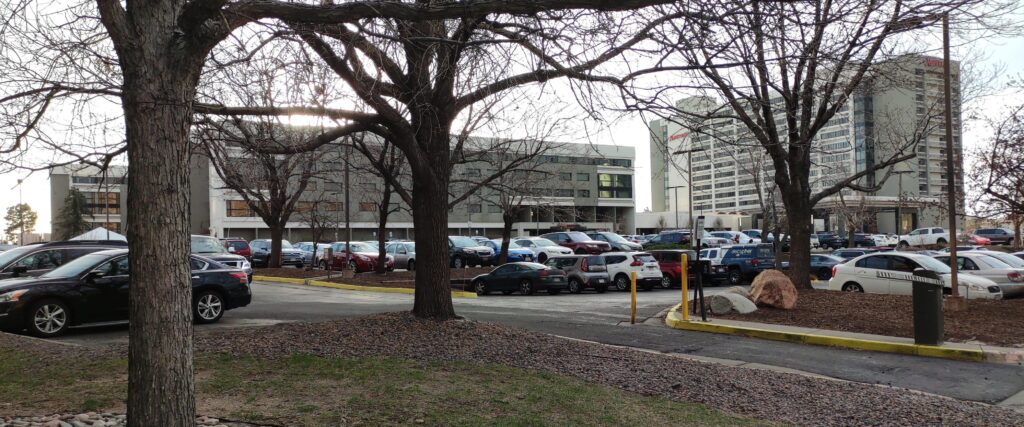“Almost the same thing, but less impactful the second time.”
If I had to sum up my experience at Colorado Anime Fest relative to Nan Desu Kan in a single sentence, that’s how I’d do it. I had a great time at NDK last year, and when 2022 began, I fully intended to go another round with Colorado Anime Fest, an underdog convention founded by ex-NDK employees. Leading up to the event, though, a few factors changed my mind– several times.
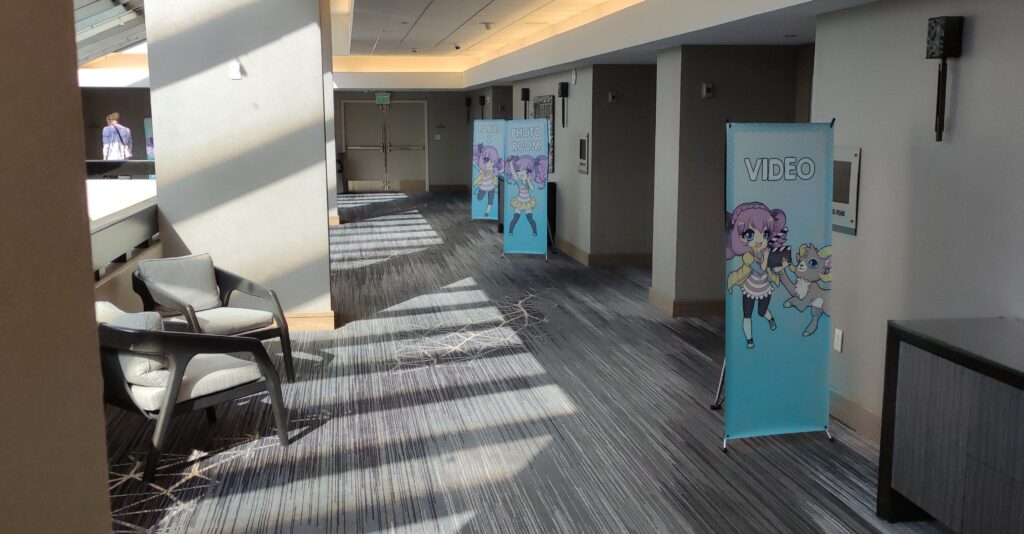
Taking place the weekend of April 15-17, CoAF wasn’t bad, but it was certainly different. There were different areas of emphasis for the convention, a different atmosphere, and some significant differences in programming.
To Attend or Not to Attend
A few weeks into the year, CoAF announced a mandatory COVID booster + mask policy, which immediately made me change my mind and decide I wasn’t going to attend this year– I went so far as to email them to let them know they’d lost my attendance. My reasoning was that NDK worked fine with only masks (no vaccine checking), and the CDC had not modified their definition of “fully vaccinated” to include a booster shot, so CoAF making up their own “as vaccinated as possible” definition and still requiring masks was simply cultural overkill on too many levels.

However, my mind was changed back by Marcus and Kelly, who I met at NDK when they held a panel about job hunting. I’ve since started attending monthly dinners they organize for their Denver Anime meetup group. These two attend a lot of anime conventions throughout the United States as press and hobby panelists, and Marcus in particular told me that NDK is his least favorite of all (with CoAF being among his favorites).
Given that I had a great time at NDK, that bold statement piqued my interest– were Marcus’s tastes extremely different from mine, or would I like CoAF even better? So with that, I got a COVID booster shot (and experienced the first vaccine side effects I’ve ever had), purchased a weekend badge (at $5 less than NDK’s pricing), and tried to temper my expectations– after all, part of the reason I enjoyed NDK so much was because I went into it expecting to regret going.
Friday Panels: Anime vs. Live Action (5:15pm-6:30pm)
I didn’t skip Friday this time, although I did miss the chance to pick up my badge on Thursday, and I also missed the opening ceremonies, both due to obligations at my day job. The first panel I attended was one of Kelly and Marcus’s, “Anime vs. Live Action.”
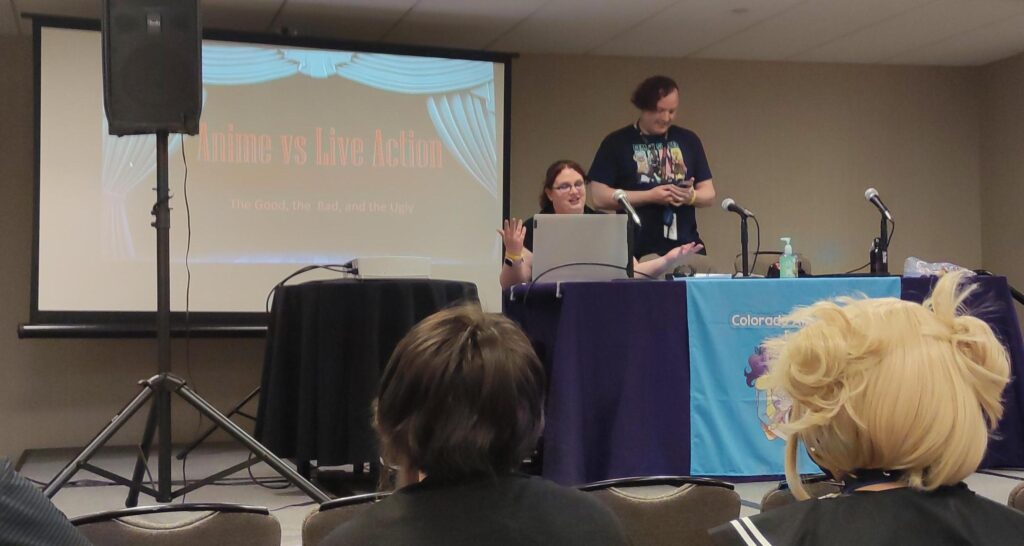
Live-action adaptations of anime can be a mixed bag. On one hand, they can greatly expand an anime’s exposure and draw in new fans who are only interested in “normal” movies or TV shows. On the other hand, they have a negative reputation with many anime fans because the writing, acting, and directing challenges of adapting over-the-top animation into the physical world often cause the end result to not do justice to the source material. This panel’s premise was to analyze what makes live-action adaptations good or bad using various examples of each.
The presentation was entertaining, with side-by-side examples edited for comedic effect. I did think the presenters ran a little light on explanations. Examples were introduced with the name of the franchise and a brief background, but after showing the clip, there was little or no discussion about what was just shown before moving on to the next one. To be fair, most of the audience could probably see what was wrong (or right) with certain adaptations, but relying on the audience’s understanding called into question what insight the panel was providing.
The brevity was partially necessitated by the limited time allocated for the panel, and I still enjoyed it despite not knowing most of the shows they talked about. In fact, I was exposed to a lot of new series thanks to the panel, which is a theme that would continue throughout the weekend.
At the panel, one of the other people from the Denver Anime meetup group (named Abel) remarked at one point, “I needed some anime convention in me.” That’s exactly what I’d been feeling before the first time I changed my mind about going; there’s an energy at conventions, especially anime conventions, that you just don’t get in day-to-day life.
Friday Panels: Ask SungWon Cho (ProZD) Whatever Your Heart Desires (7pm-8pm)
Aside from Marcus’s recommendation, there was actually one other thing that pushed me over the edge into buying a ticket: one of the guests was SungWon Cho, also known by his username ProZD, who’s a live-action YouTuber and professional dubbed anime voice actor. I’m a particular fan of his Vine-esque one-man skits as well as the RocketJump/Crunchyroll production Anime Crimes Division that he co-starred in.
Something I remarked about NDK was how small all of its panels felt, and CoAF took that to another level. I was expecting the ProZD AMA to have some kind of line to get in, especially after I saw how small Panel Room 1 was. Instead, the seats weren’t even full by the time the panel started. (This was for a YouTuber with 3.75 million subscribers!)
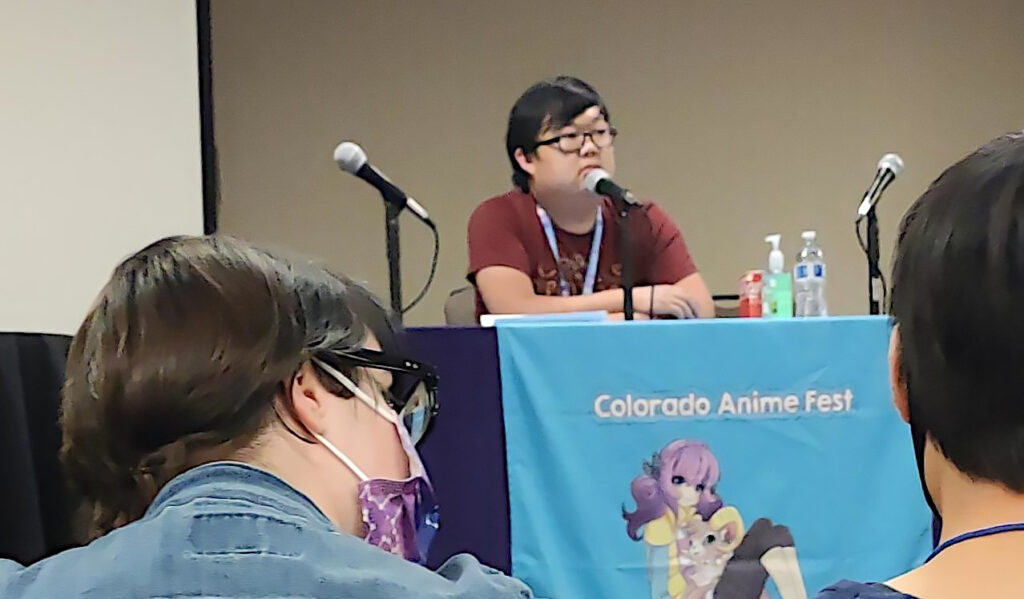
SungWon was just as relaxed in-person as I expected him to be, and he simply asked the room to line up in the aisle between the chairs to ask questions. The line hovered around 5 people long the entire time, with a couple who kept cycling through (which was helpful, because the panel would have run out of content if people weren’t asking multiple questions.) I asked two myself:
- SungWon mentioned how competitive the voice acting industry is in some of his other answers, and one of the reasons I didn’t go into a creative field professionally was because I didn’t want to ever be forced to work on anything I don’t agree with, so I asked if he ever auditioned or felt the need to audition for work that he didn’t really want to do.
- His answer was pretty simple: no. If there’s a job he wouldn’t feel comfortable doing or wouldn’t be particularly interested in, he just wouldn’t apply.
- I later asked if he’d ever played a game or watched a show because it had a voice actor that he really liked (this question got his attention more.)
- His answer was no, he doesn’t choose what to play or watch based on the voice actors, although he does sometimes choose to play a game in English rather than Japanese if it has voice actors that he knows and enjoys.
Like most of the panels, this one wasn’t groundbreaking, but was entertaining nonetheless.
Friday: Video Game Room
Like NDK, CoAF had a video game room filled with Japanese arcade games and some set-top consoles. Both sections were significantly smaller than the NDK equivalents, with the CoAF tournament projector feeling a little sad shoved in a corner behind a few cramped console tables. The arcade section was a single perimeter around the larger side of the room.

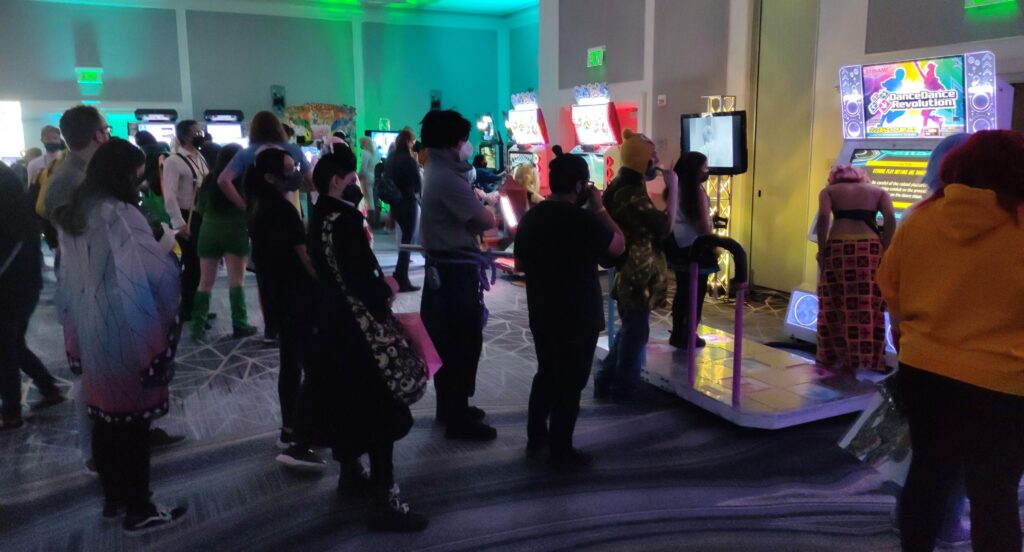
Of course, quantity isn’t everything. There were a few machines that caught my eye. Aside from the intriguing rhythm games (which I wouldn’t want to play in such a loud room), I saw gems such as a pair of Japanese Mario Kart arcade machines, which I played two rounds on.
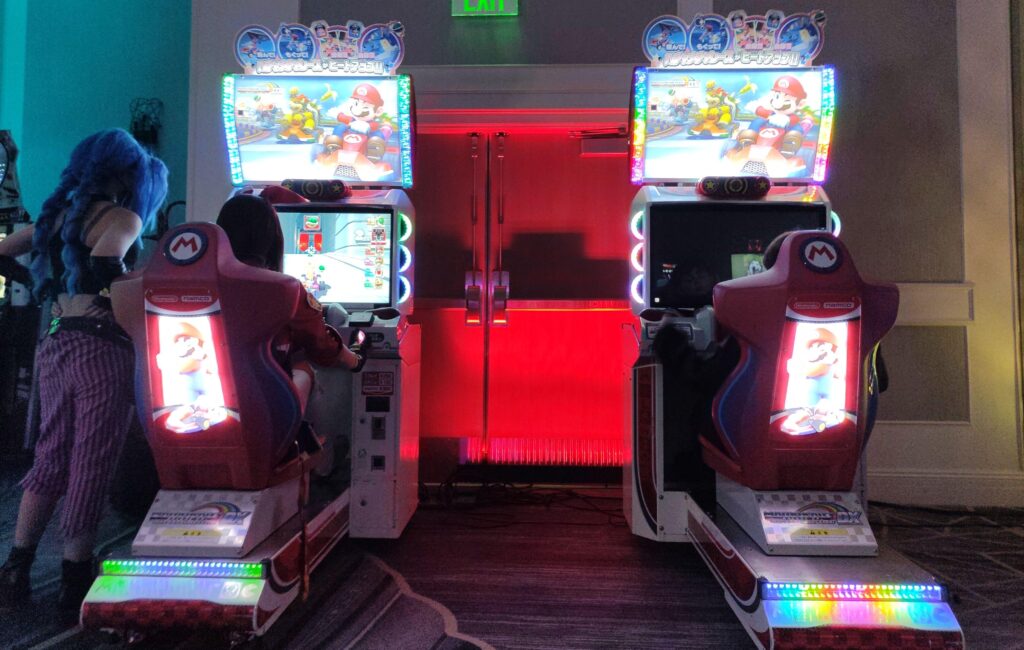

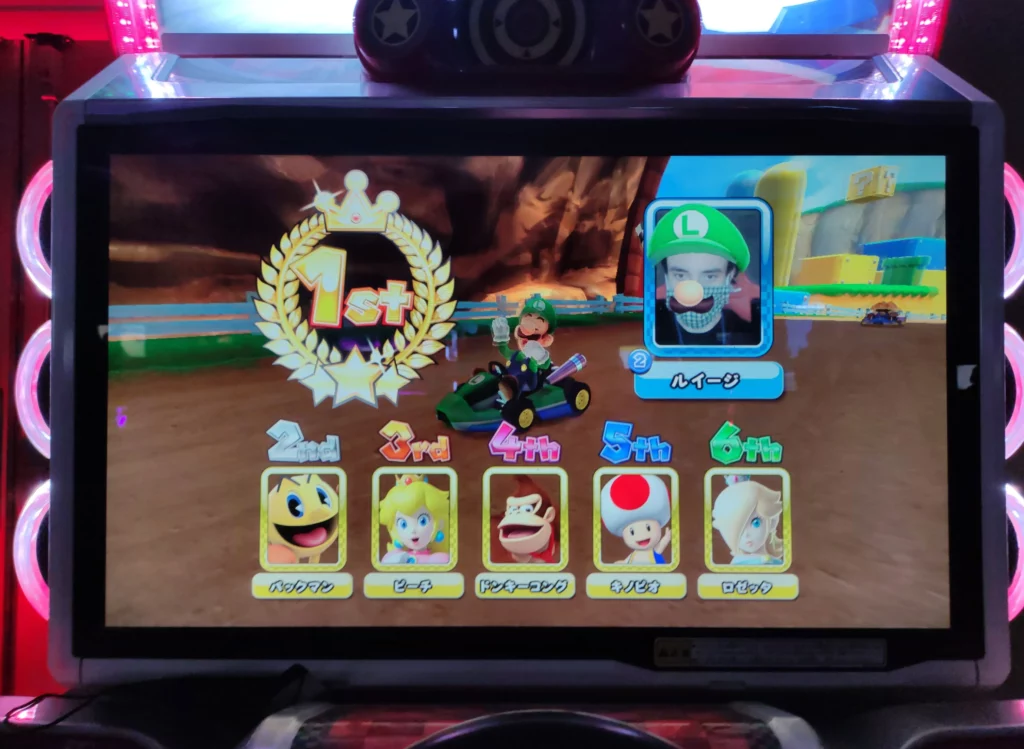
There was also another exciting one. You may remember from my NDK blog post that I was “tempted to get in line” for a futuristic mecha game. CoAF had two of that game.
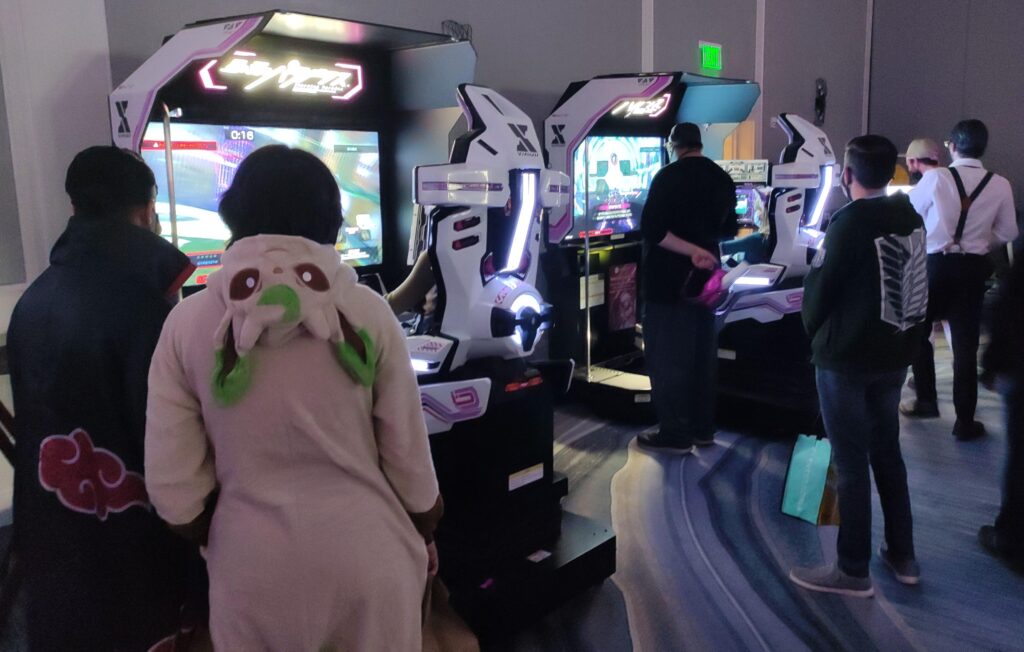
I played it twice over the weekend, the first time being on Friday when the room was still fairly slow. It was as fun– and complicated– as it looked. The controls consisted of a joystick in each hand, both with several buttons; two pedals, one under each foot; and a touch screen attached to the right side of the chair, which occasionally displayed prompts in Japanese.
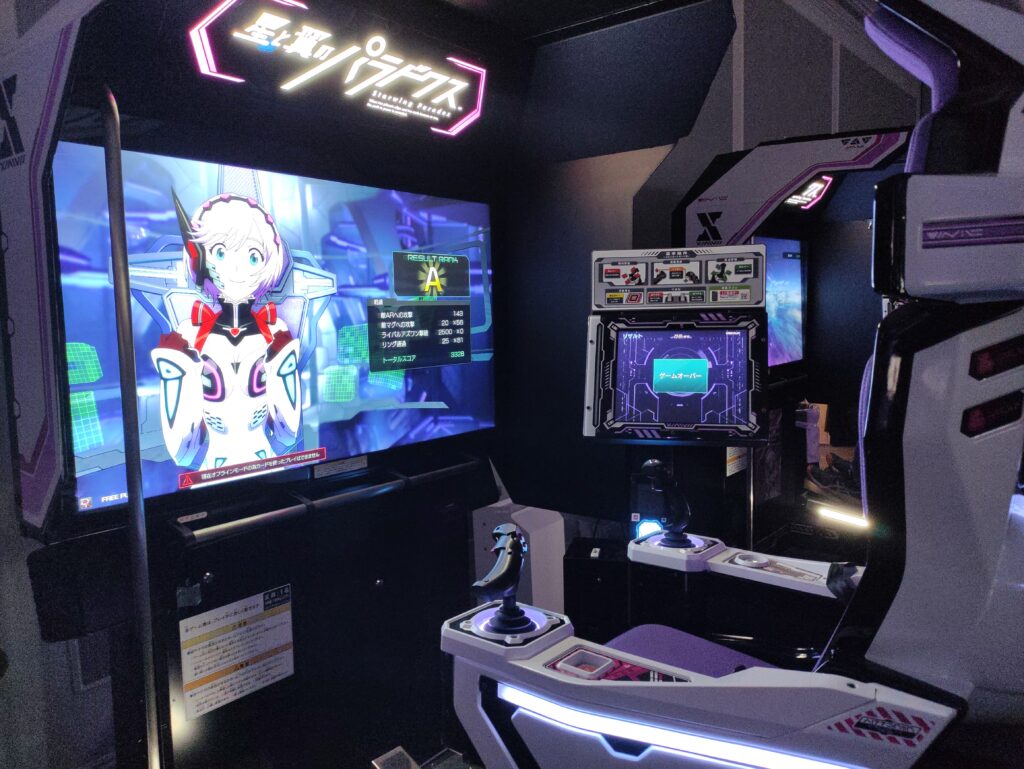
Speaking of Japanese, all of the instructions were in it. It was a pleasant surprise that I actually recognized some words here and there, and especially that I’d retained a bit of katakana recognition that I’d been working on (e.g. being able to sound out ドリフト as drift.) On the other hand, there was still plenty I didn’t pick up on in my limited time playing (especially where the controls were concerned), and I ran out of lives on what I believe was still the first level.
Friday Video: Redo of Healer (10pm-11:15pm)
Like I mentioned, CoAF has some significant differences in programming compared to NDK. You might remember that NDK allows 18+ panels, but doesn’t allow showing explicit content on the panel projectors, so panels relating to hentai have to rely on verbal description and imagination. One thing that caught my attention while browsing the schedule was that the video room at CoAF had time slots blocked off for 18+ content along with the panel rooms, which meant that they’d actually be screening hentai.
(Aside: outsiders typically associate the word “hentai” with pornography, but it’s actually a broader term that covers extreme violence or profanity in addition to sexually explicit material. The word “hen,” written 変 or へん in Japanese, translates to “strange” or “indecent,” and while it can carry a sexual connotation, it’s just as much about being socially unpresentable for any reason. In anime, “hentai” can cover what western media would classify as NC-17 or R-rated content in addition to outright pornography.)
Having searched the synopses for the scheduled shows, I’d singled out the first and last ones as being potentially interesting, with the two in the middle being less tasteful. The video room host introduced the block with some ground rules (unlike the daytime anime screenings, verbal banter was encouraged for the hentai; “hand checks” would supposedly be performed regularly, although I can only recall one time that was done.)
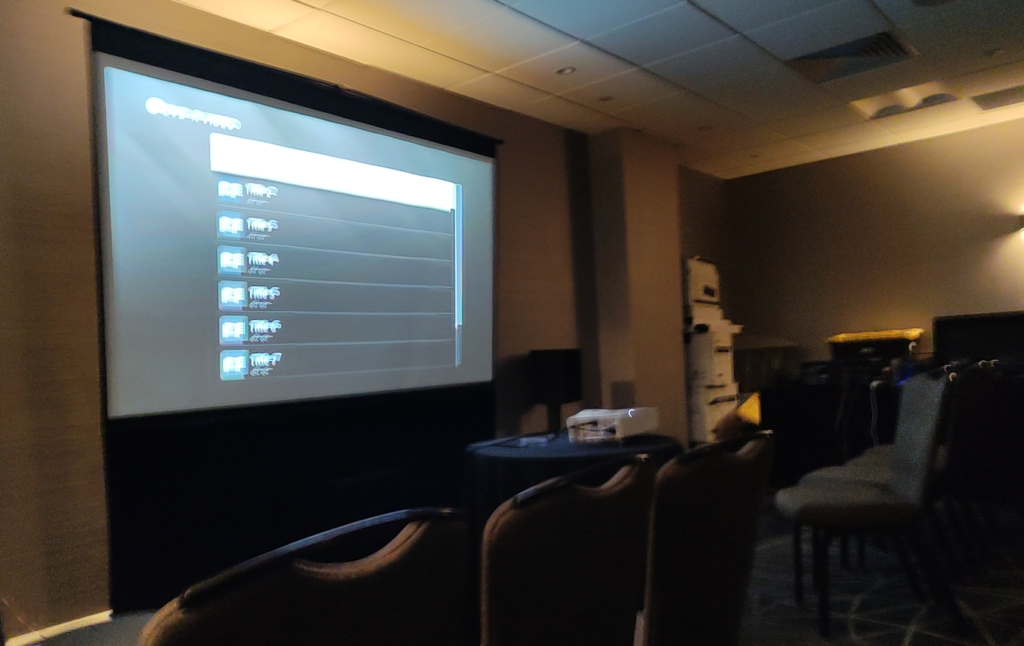
The first show screened was the uncut/uncensored version of “Redo of Healer” (the title sounds odd in English, but it can be interpreted as “The Healer’s Redo” or “The Healer’s Second Chance.”) The premise of this story is that a young man is living life in a simple village when it’s discovered he has a magical healing ability, leading the land’s royalty to conscript him as part of a prestigious band of heroes fighting against an evil demon lord (a classic anime antagonist.) However, while life as a hero appears to be luxurious at first glance, it’s soon revealed that his healing ability causes him to experience the pain and suffering of whatever injuries or illnesses he heals. When he tries to back out, the rest of the party forces him to stay, first drugging him to keep him in line and eventually escalating to beyond-unreasonable levels of physical and mental abuse.
The healer’s turnaround comes when the party’s finally about to defeat the demon lord (this is still Episode 1.) In the battle’s climax, the healer neglects to heal the rest of the heroes as they’re critically injured one by one; he waits until they’ve whittled the enemy down to near death, then kills the demon lord himself, receiving a magical wish-granting stone as a prize. Using this stone, he travels back in time to before he was conscripted into the royal class and immediately begins preparing for his “redo” of life, building up a tolerance to the drug he would later be abused with and learning more offensive magical abilities to complement his healing. He acts along with the original course of events long enough to let the royalty believe he’s been brought into submission, then kicks off an elaborate plan to get revenge on everyone who wronged him while still working towards confronting the demon lord a second time.
The video room presenter stated “Redo of Healer” was one of his favorite anime of 2021, and while I’m not sure it’s quite that high on my own list, it was certainly an engaging story. A group came in behind me near the end of the first episode, and I explained the premise to them while the second one was being loaded up, which helped me appreciate how coherent the plot was. We only had time to watch the first two and a half episodes (out of twelve) before the allotted timeslot was over, and I was disappointed to see it go (I didn’t realize the timeslots were scheduled shorter than the actual runtimes of the shows being aired, since the schedule didn’t include episode numbers.)
After seeing that the video room could be entered and left at any time, not just when screenings were starting/ending, I did stick around to see the start of the next hentai show before the panel I was going to attend; I won’t name this one, but as I expected based on its synopsis, it was a more stereotypical pornographic hentai… except it was dubbed from Japanese to English, complete with translation quirks and over-the-top voice acting. Where the first show had commanded the audience’s quiet attention, this second one had the whole room laughing. Snide remarks abounded, and particularly gross acts evoked audible reactions that I’m pretty sure could be heard from across the hall. I wasn’t sure what to expect from this room, but this second show (and its reaction) was much closer to what I had pictured, although I’m glad that the first show surprised me.
Friday Panels: Learn Japanese Through Hentai (11:45pm-12:45am)
Next on the docket was a panel that caught my attention because I am currently learning Japanese. Unfortunately, it was a little disappointing. The panel description stated it would be “educational,” although that word was in quotation marks, to the panelist’s credit.
This panel’s slideshow was structured to present a short (10-second) clip of hentai with Japanese voicing but no subtitles. The next slide would present a multiple-choice list of possible English translations for what was just said; the panelist would survey the room for who believed each answer. Finally, the clip would be played again with English subtitles.
My disappointment with this panel was that the panelist didn’t actually know much Japanese at all. After showing the correct answer, the panelist would call out some of the people who voted for the correct answer and ask what Japanese words they recognized to help them determine the correct answer. (Anyone who chose to respond to this portion would get to choose a lewd sticker to take home from the table at the front of the room, and I did get one myself, pictured below.)
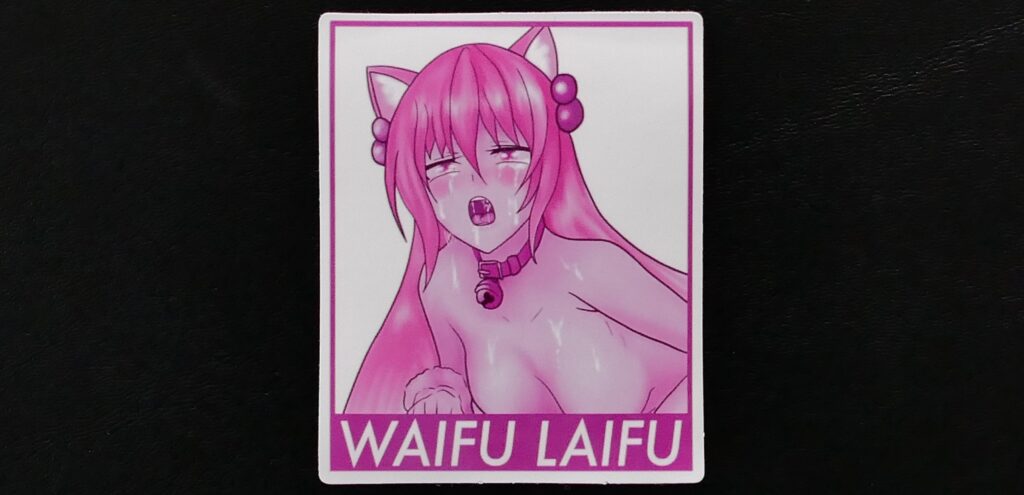
But the panelist didn’t actually seem to know whether anyone’s answers were correct or incorrect; he was genuinely asking them how they knew, and if nobody had an answer, he would just move on instead of explaining it, which meant there was absolutely no “education” involved in this presentation. The phrases themselves were rudimentary, with almost all of the answers being guessable based on an anime fan’s common knowledge. If there was a plus side to attending this panel, it was that it validated my Japanese self-studying as being incredibly legitimate in comparison.
Friday Video: Mezzo Forte (1:15am-2am)
I returned from the dud panel to the video room to catch the end of the third show just before the fourth started. The third show (which I won’t name) was another more vulgar story involving an underground society at a school roping students into nonconsensual acts, which was pretty uncomfortable and was not evoking the laughter that I’d left earlier. The fourth show, though, was interesting.
Titled “Mezzo Forte,” the final show of the night opened on what appeared to be a heist; two undercover agents were making a “delivery” of what appeared to be a prostitution robot (but ended up containing a bomb), while their partner in a car outside, who was supposed to be listening in for the signal to facilitate their escape, got distracted by a police officer (and former co-worker) questioning what he’s been up to since leaving the police force. The escape doesn’t go as planned and shenanigans ensue.
It’s later revealed that the trio has been trying to take down the leader of a ruthless organized crime organization (who owns a baseball team as one of his fronts), but has been running short on money to the point of not being able to eat properly. The organized crime leader has a daughter, who’s around the same age as one of the three good guys, and who’s just as ruthless as her father. The group carries out an elaborate plan to abduct the crime leader while he’s in the bathroom at a bowling alley, but the execution’s botched and they attract the attention of the crime leader’s daughter while they’re exiting. After they’ve escaped, they discover that they accidentally killed the crime leader during the ordeal… but his daughter doesn’t know that, and now that she knows their identities, they have to bluff their way through hostage negotiations as they devise a plan to take her out before she does the same to them.
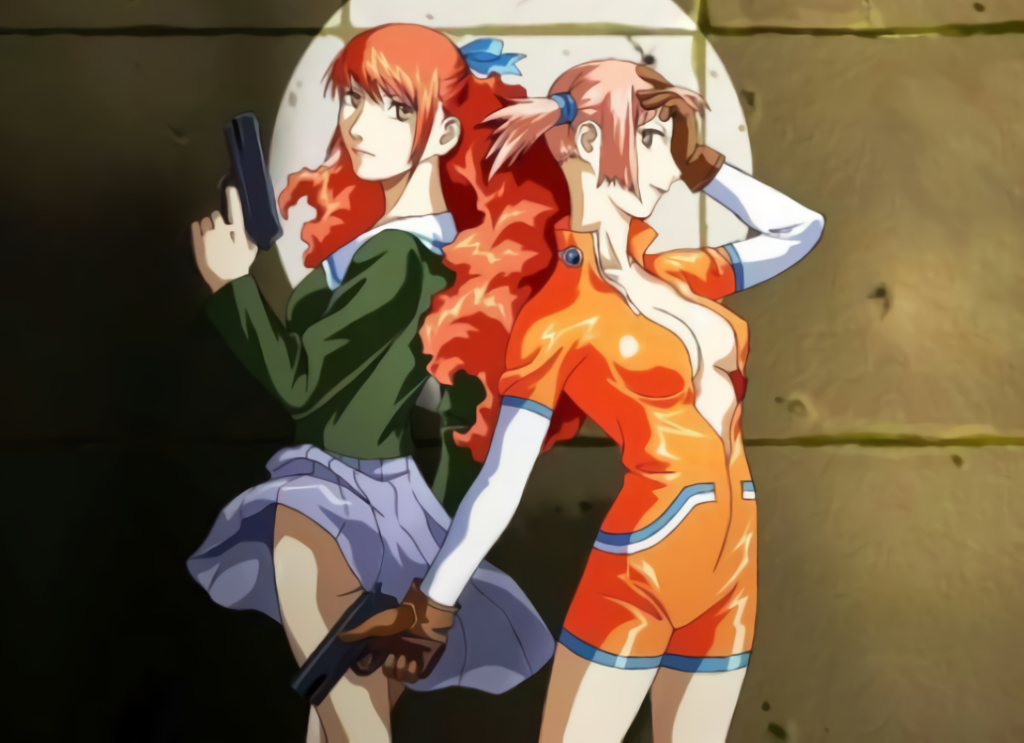
This one left me on the edge of my seat wondering how they’d get themselves out of the mess they created, thinking about it for the whole drive home. We’d just watched the first few minutes of Episode 2 when the convention closed for the night, and upon looking this one up afterwards, I was disappointed to see that only two episodes existed (so whatever the conclusion, it must be pretty succinct.) The one sexual scene in the first episode felt entirely unnecessary and didn’t impact the plot in any way, and I suspect this was a story that got converted into a hentai to secure funding that would have otherwise been unavailable. This OVA was eventually succeeded by a slightly longer show simply called Mezzo.
Having completed the first day of the convention and returning home much later than I did during NDK, I tried to clear up some issues with a cell phone I was testing at the convention for my YouTube channel, ate a couple of oranges as a meager meal for the day, and went to sleep not quite sure what the next day would look like.
Saturday: Parking Fiasco 2, Electric Boogaloo
I covered in my NDK blog post that the con was short on parking spaces, which was a problem at the Gaylord Rockies hotel and resort because the grounds, located in Aurora, were geographically isolated from any surrounding businesses or parking lots. CoAF, in comparison, was held at the Denver Marriott Tech Center, a hotel in the southern DTC neighborhood of Denver proper. While I didn’t run into any parking problems at NDK, I did get hit with the lack of a parking spot at CoAF on Saturday, which I attribute to arriving multiple hours after opening time on the busiest day of the convention.

After driving through both of the hotel’s parking lots a few times and not wanting to risk parking in a no-parking space (which I saw some others doing), I ended up leaving and finding a parking garage instead. (Apparently, some people were parking immediately across the street from the hotel in an office building’s parking lot; I’m not sure whether that was legal or why I didn’t try that, only that I didn’t see it in time.)
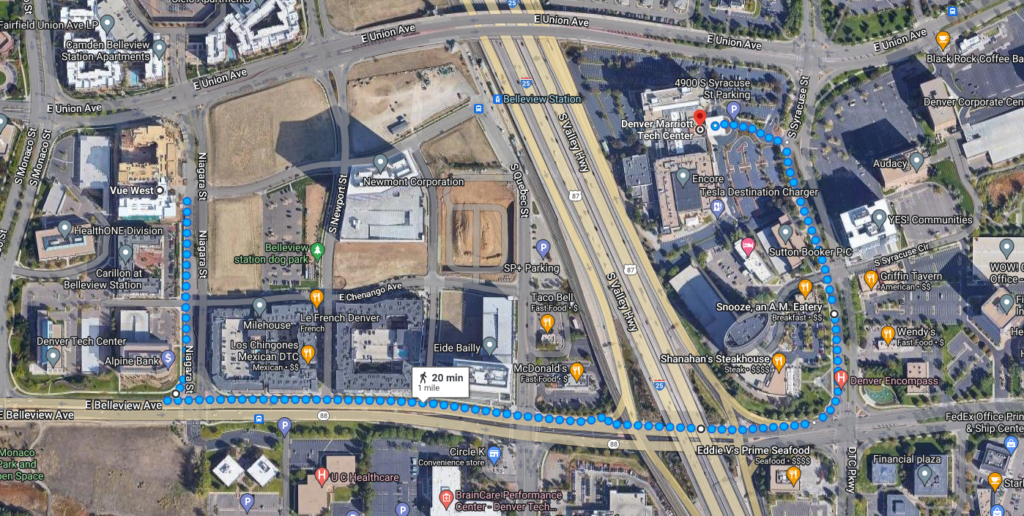
The garage I ended up using, which turned out to be a visitor’s parking garage for a “luxury” apartment complex (rated 3.4 stars with lots of horror stories on Google Maps), ended up adding an extra $16 to my costs for the weekend. On entering, I was given the option to either take a ticket or swipe my credit card as my ticket. I chose the latter option, which came back to bite me later.
This parking experience started a trend for the rest of the weekend of really highlighting the downsides of attending a convention alone. If I’d been there with a friend, I still would have needed to deal with parking, but I wouldn’t be the only one with skin in the game. If I were to miss a panel I wanted to see, at least I’d be missing it with someone else. Someone else would be there to check what I’m doing (e.g. pointing out that people appeared to be walking over from the office parking lot across the street.) If my car was to get towed for parking illegally, it wouldn’t just be my problem alone. And so on.
Alas, I walked the nine blocks to the convention center and continued on with my day.
Saturday: Autographs (SungWon Cho)
Given that I was actually excited about one of the guests at CoAF (unlike NDK), I decided to try and grab a photo with SungWon Cho, having heard him mention it was free during his panel the previous day. The autograph and photo setup was located in the vendor hall, which was somewhat loud. The convention staff member giving instructions for the autograph line had to stop talking several times when a different staff member started making announcements over a loudspeaker for the vendor hall.
This was one of the only times I actually had to stand in line at CoAF, and it was a great opportunity to check out peoples’ cosplays, both in the autograph line and in the rest of the vendor hall. I would estimate that the proportion of attendees wearing cosplay at CoAF was significantly higher than at NDK. I never once felt out of place wearing normal clothes at NDK, but there were a few times at CoAF when I actually felt like I stuck out not being in costume.
The line went fairly smoothly, and having worked out my phone’s camera issues the previous day, I was able to successfully get my picture taken by a convention staff member.
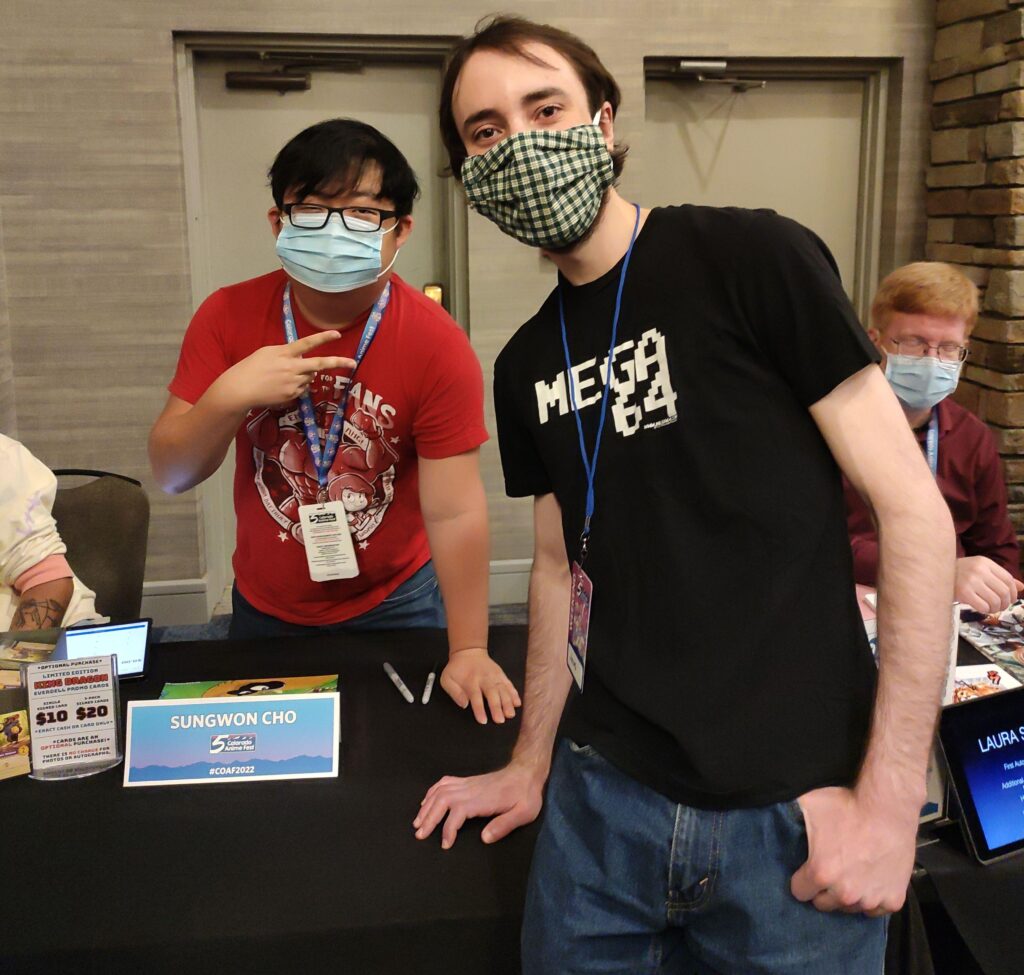
Of course, like any time I attend one of these meet-and-greets, I didn’t have much to say to SungWon besides “I’m a big fan of your work, keep it up!” I didn’t even bother having him sign my convention badge, since I figured having a photo with him is proof enough that I met him.
The next event I had scheduled was SungWon’s second panel, which was still over three hours away, so I had some time to kill.
Saturday: Manga Library
One of the other unique features of CoAF that NDK didn’t have was a manga library. This was a quiet room full of manga to browse and read. (Manga is essentially Japanese comic books, with more pages than American comics but a similar proportion of pictures to words.) I actually spent some time in this room on Friday (and spent more time in the video game room Saturday), but I figured it would be better to space things out in the blog post.
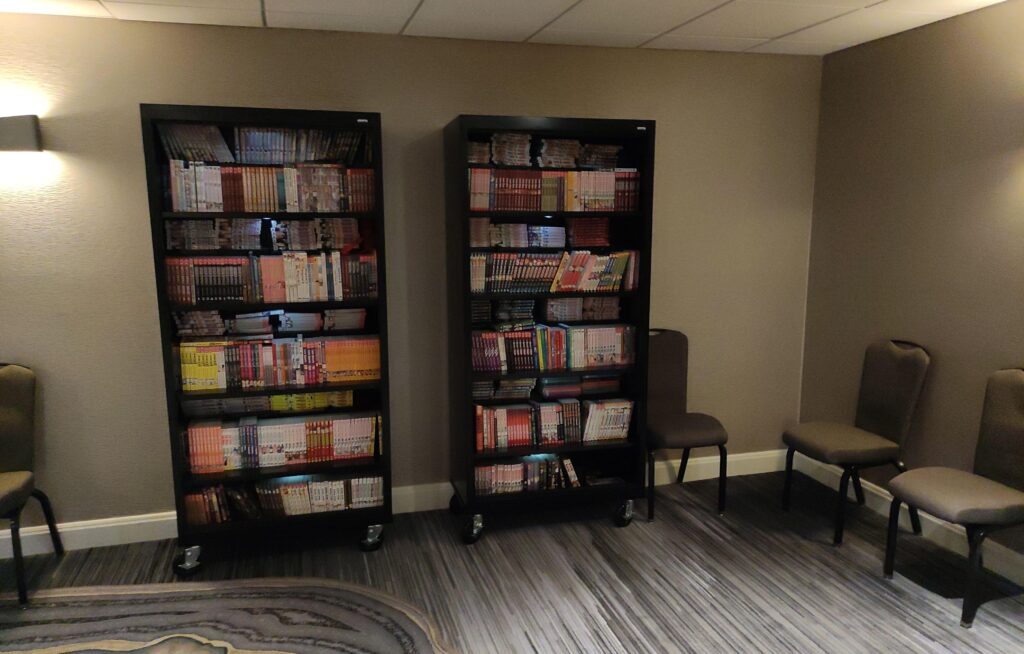
The manga was not for sale; it was all brought by volunteers. Interestingly, a group would occasionally come in and ask the volunteers whether it was for sale, then leave when they found out it wasn’t. I suppose some people would rather spend their convention doing things other than reading, but for me, this was a great alternative to just walking back and forth down the hallways like I did a ton at NDK.
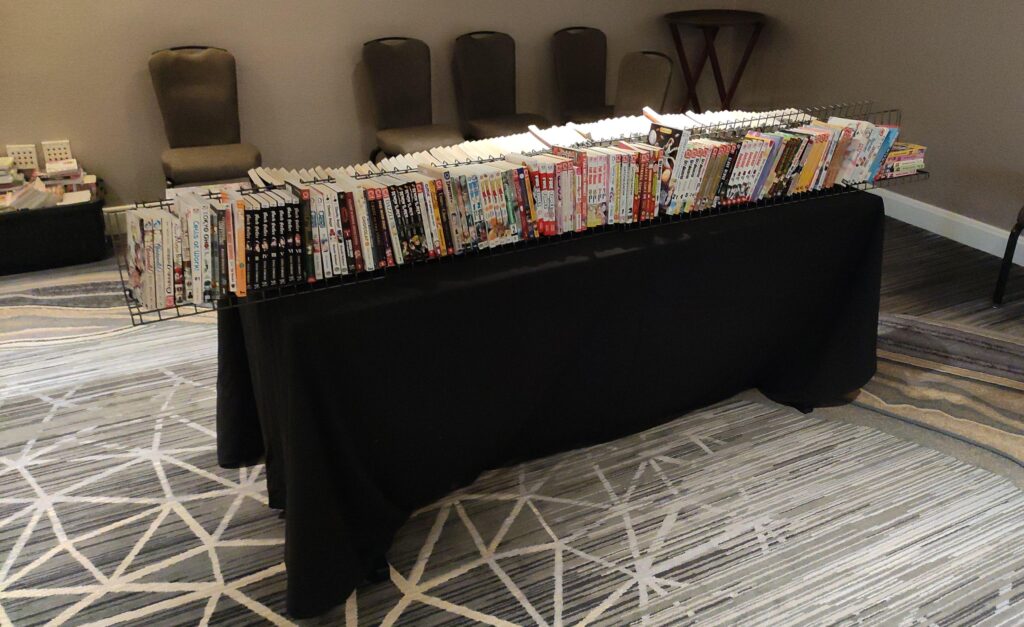
I’m not actually the biggest manga fan. I have friends who read manga about men fighting in hand-to-hand combat, which doesn’t really interest me. I legitimately enjoyed an official Girls und Panzer spin-off manga, Ribbon Warrior, which has a nice mixture of exciting action, more significant conflict than the GuP anime, and more eye candy than what I would expect from a lot of mainstream fighting manga. Another GuP manga, Motto Love Love Sakusen Desu! (abbreviated MLLSD), leans a little too far into meaningless fluff to keep my attention for very long in a single reading session.
So browsing the manga library, I was looking for something fairly lighthearted– not overly violent, and not dark enough that the plot would be complicated to understand. I was also looking for something that didn’t scream “over-the-top bishōjo artwork,” but would still be nice to look at for a while. Finally, I was on the lookout for any characters or franchises that I already knew about, since that can make getting into a story easier. I eventually came across an unexpected one: Hatsune Miku.
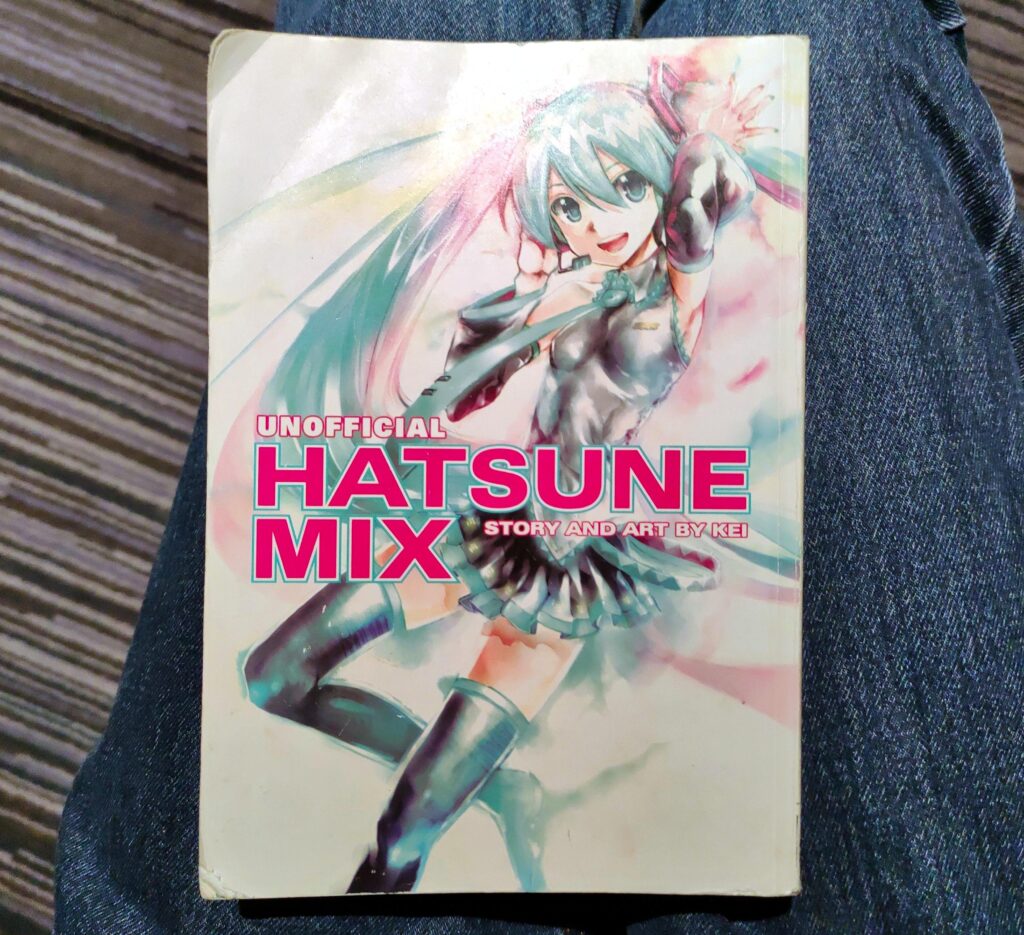
Miku is a vocaloid, which means “she” sings music, but there’s not actually a real person singing her voice (she’s not a V-tuber.) Instead, the voice is entirely computer-generated, based on one-time human sampling along with extensive processing. This means musicians can purchase a virtual instrument that lets them type in the words and notes they want Miku to sing, rendering the result to use in their songs.
The nature of Miku as more of an instrument than an artist means the usage of her likeness is very widespread, although the Miku character is protected by copyright and can’t be used freely the same way as the voice. Still, you’ll find Miku in songs from a variety of artists, and you’ll also find her character in lots of different styles and genres of content. This makes wrapping your head around her fanbase difficult, and it’s also given rise to a “Miku is a ___” catchphrase used when Miku shows up in a new place– for example, one of the panels at NDK was called “Miku is a Racecar Driver?! The History of Driving Miku.”

I had actually looked up one of Miku’s songs for the first time just before NDK and had it stuck in my head the whole weekend, so when I spotted her on the cover of a manga, I figured it would be apt to include her in this anime convention experience too. The manga was an anthology of short fluff stories, very similar to the Girls und Panzer MLLSD manga I mentioned earlier. Most of the chapters were completely standalone, but there would occasionally be one that called back to multiple earlier storylines, typically the last one in a section.
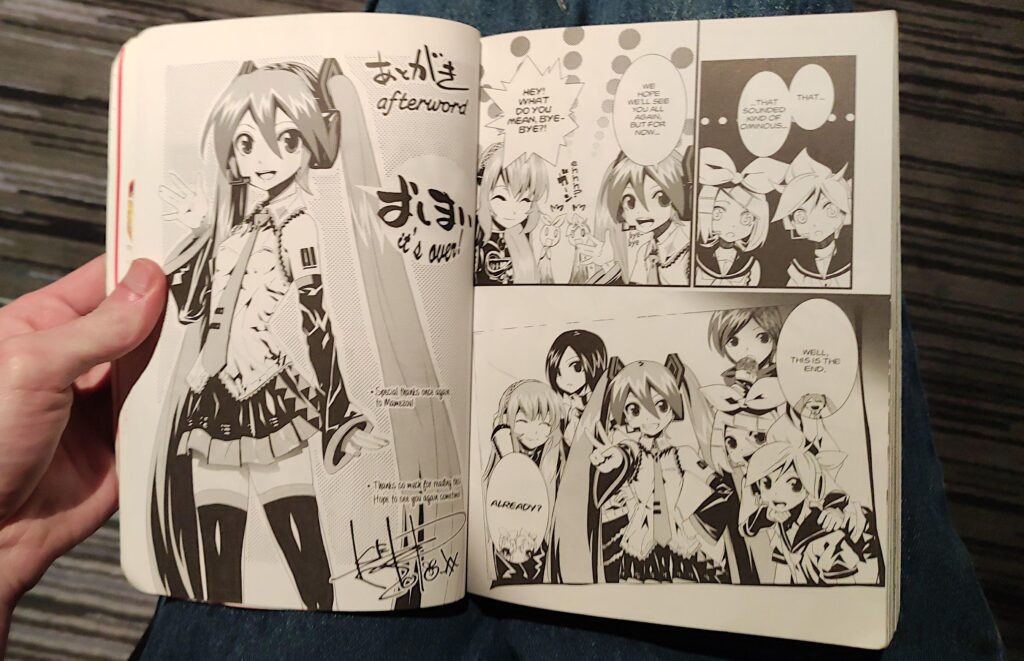
Between Friday and Saturday, I ended up making it all the way through to the end of this manga, which seems to run for around $25 new on Amazon (it’s “unofficial” as far as the Miku character goes, but it’s created by Miku’s original artist.) Sure, it wasn’t the deepest or most thrilling story, but did it beat walking around aimlessly in the hallways? Absolutely.
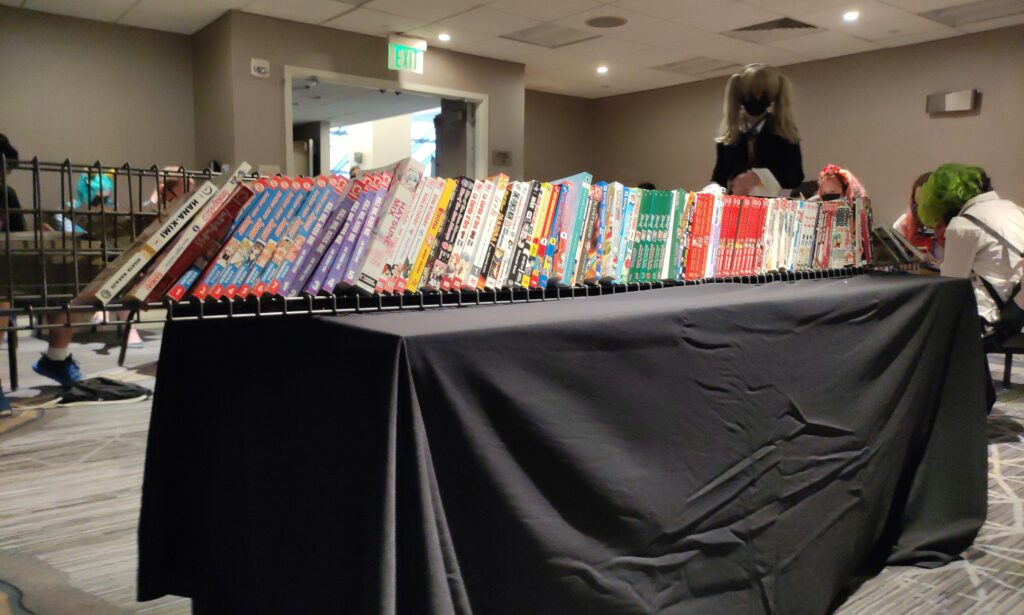
There was only one downside to the manga library, and that was that the volunteers supervising the room started getting pretty chatty towards the end of the day on Saturday. The manga library was located across the hall from the convention’s actual “quiet room,” but on Friday, it almost seemed to be a quiet room with entertainment, with everyone silent and focused on reading. But on Saturday, several times while I was reading throughout the day, a friend or two of the organizers would wander in and start having a loud conversation. Worse, the conversations eventually turned to one of the organizers complaining about their family’s political views. Ironically, I heard them talking about how they didn’t want to worry about politics in their own home and they just wanted to be able to relax– which is exactly how I felt about the manga library that they were ruining.
For that reason, I ended up kind of rushing through the last few chapters of the book on Saturday while partially distracted so I wouldn’t have to worry about coming back on Sunday, which was a disappointing way to end it off. Still, the manga was a fun read, and I definitely think the manga library was a great idea to have at CoAF.
Saturday Panels: Rating Your Anime Wives and Husbands LIVE with SungWon Cho (4pm-5pm)
SungWon’s a talented voice actor and a skilled skit writer, but sometimes he makes content just for fun, and one example of that is his asking his Twitter followers to send him their anime waifus and husbandos, then “rating” them on a scale of 1-5 in quick succession. He mentioned during his earlier Q&A panel that he simply enjoys arbitrarily rating things.
Out of all the panels I went to at CoAF, this was the only one that actually filled up entirely. There were overflows sitting in the aisle between the chairs and standing along the back walls and in the doorway. I managed to get a seat myself (thanks to my tendency of always getting to panels I want to see super early), but I appreciated from an organizational perspective that CoAF allowed attendees to sit in the aisles or stand by the doors instead of just counting the number of chairs and turning any excess attendees away. It made for a less formal experience, which in turn makes the convention seem more personal.

The rating commenced, and the panel didn’t contain much substance compared to the previous day’s Q&A, but it was still entertaining to watch. Audience members raised their hands and were called on to shout out the name of their waifu or husbando (or any character they wanted SungWon to rate.) SungWon’s responses to characters were sometimes based on prior knowledge and sometimes based on only a first impression. He had a co-panelist for this panel who would do a Google Image search for any character being discussed, and the co-panelist or audience members were sometimes asked to give a brief description of the character, which was sometimes humorously succinct. (“Tell me about her.” “She’s tall.” “She’s tall, that’s it? Does she have a personality?”)
The relative popularity of this joke panel compared to the previous day’s Q&A session reflects a major challenge of YouTubers: what the audience wants isn’t always the most interesting or substantial content, but it’s sometimes instead just the lowest common denominator. Still, SungWon handled the room and put on an entertaining performance, as expected of a professional.
Saturday Panels: InsideJapan – More Than Just Tokyo! (5:30pm-6:30pm)
This was one of those panels that I walked into without really understanding what it was. From the title and description, I thought this was going to be some kind of presentation about Japanese culture, particularly in areas more rural (or at least less famous) than the capital, Tokyo. It was actually (kind of) an advertisement panel for a tourism company called InsideJapan.

On the way in, I was offered an informational booklet containing details about the company’s various offerings. This was the most substantial piece of free swag anyone gave out at the convention, and it really put the con’s own single-sheet schedule to shame.
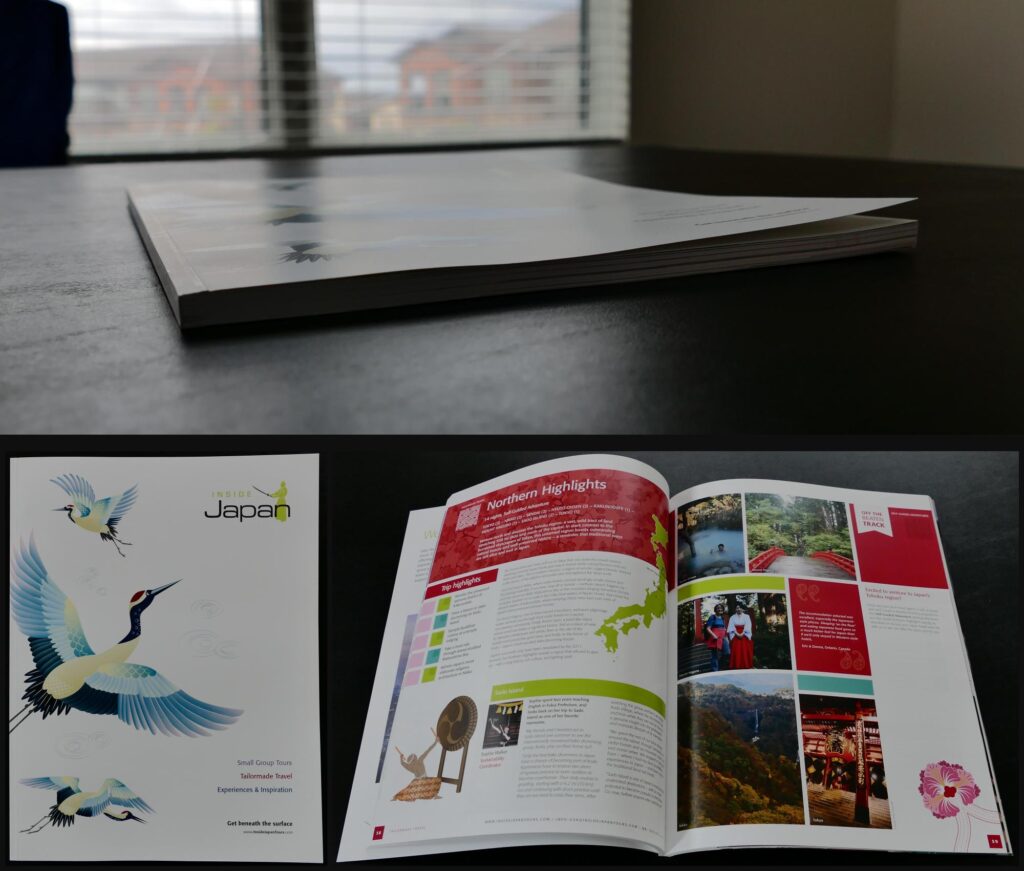
I have been wanting to make it over to Japan (if their borders ever re-open), so I didn’t actually mind hearing about some of the places I might want to go from a company specializing in travel. The hosts were very passionate and well-spoken. The company offers group tours with varying levels of guidance, and also organizes itineraries for individuals who want to explore on their own. There are different tour packages that cover different areas of interest (food, sports, nature, anime, etc.)
Perhaps the most memorable part of the panel was a very short video featuring two of InsideJapan’s tour guides explaining the difference between Buddhist temples and Shinto shrines.
The very different religions from what we have in America and Europe are one of my big draws to the east, and not having much knowledge about them at all, I really appreciated this video’s very basic explanation of the two main ones in Japan.
If I were to visit Japan, I typically assume that I’d want to go on my own to explore privately. However, I do like structure, so if I was going to go to Japan without going for a specific convention or concert, then having a guided tour with a small group to follow around might not be a bad idea. Japan’s very gradual border re-opening is also favoring guided tour groups over individual tourists, which is another selling point for tour companies.
After this panel, I didn’t want to be carrying around the large booklet for the rest of the night, so I made a quick jog through Denver’s trash-ridden streets to the parking garage and back to stash it in my car.


Saturday Panels: Worldbuilding in Fiction (7pm-8pm)
I’ve written some fiction myself (namely, Displaced), and have also been wanting to get some new story ideas down on paper, so while it’s not my top priority and I don’t think I need help with worldbuilding in particular, I figured it couldn’t hurt to hear a random panelist’s thoughts on telling better stories.
The “random panelist,” who goes by Jim Shady#5626 on Discord, has worked as an editor for some publication companies in the past, and has seen his share of authors both good and bad. The presentation wasn’t about winning strategies so much as pitfalls to avoid.
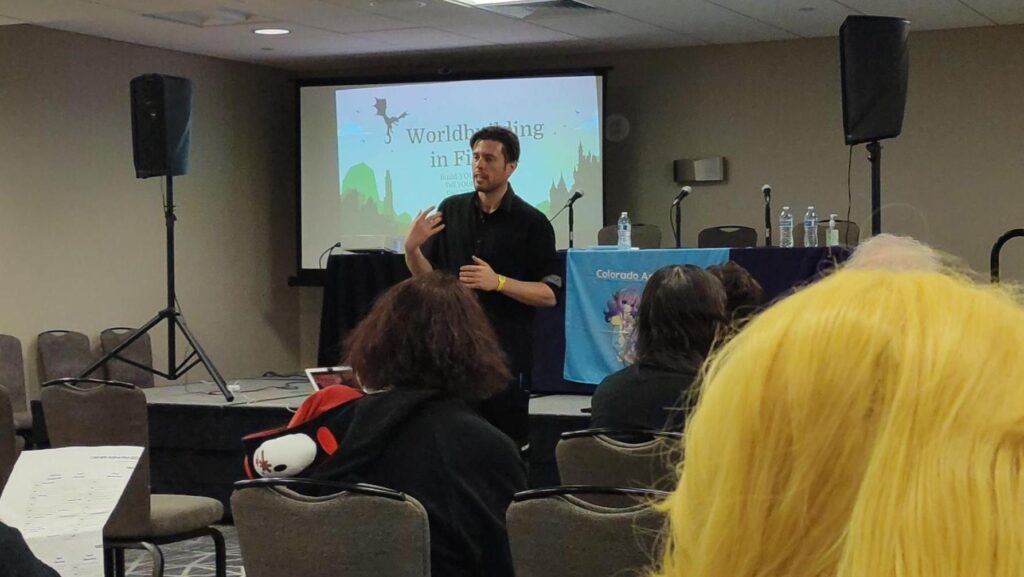
For example, a lot of the tips revolved around “show, don’t tell,” the concept that it’s better to demonstrate characters’ personalities through their actions than simply listing things off to the reader. Comparing the elves in your story to the elves in The Lord of the Rings really shouldn’t be necessary, because either your elves should be able to stand on their own, or they aren’t written well enough to use anyway. And while subverting a reader’s expectations can be useful on occasion, doing it too often or in ridiculous ways can cause the suspension of disbelief to fall apart.
The panelist had plenty of example excerpts and solicited verbal feedback from the audience multiple times. Overall, this panel wasn’t anything groundbreaking, but it was competently presented.
Saturday: Fire Alarm
I had two hours to kill between the end of the last daytime panel and the start of the first evening panel. I visited the manga library and the video game room again, and eventually sat down on a couch in the lobby to start writing up this blog post.
I will say that compared to the Gaylord Rockies where NDK was held, the Marriott Tech Center was harder to kill time in. The hotel itself was smaller; the convention areas were not as separated out from the guest rooms and the public lobby. Walking back and forth through the hallways didn’t work as well because the hallways were much shorter and were also more crowded, so there wasn’t much to see and there was always a risk of getting stuck in foot traffic. The hotel’s interior decoration and external surroundings were both less scenic than the “resort” of the Gaylord Rockies.
There was an “anime bar” running that was hosting trivia throughout the weekend (it didn’t really catch my interest because I don’t drink and didn’t have a group for the trivia), as well as an open restaurant space immediately adjacent that looked like too much of a sit-down place to consider going to alone.
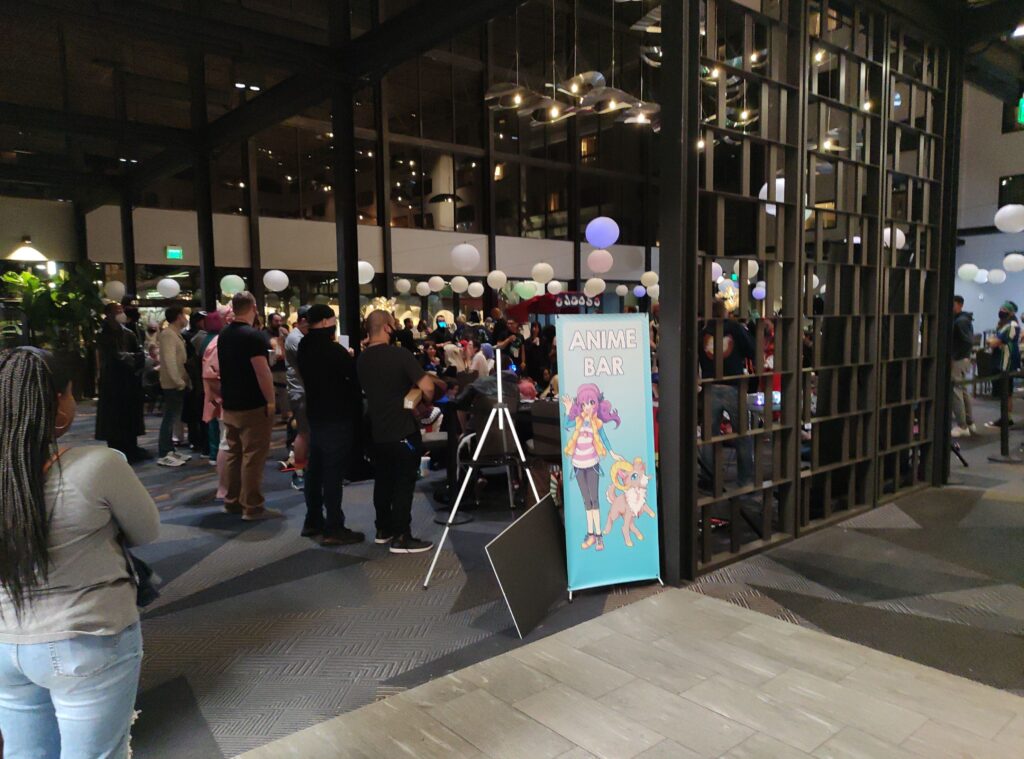
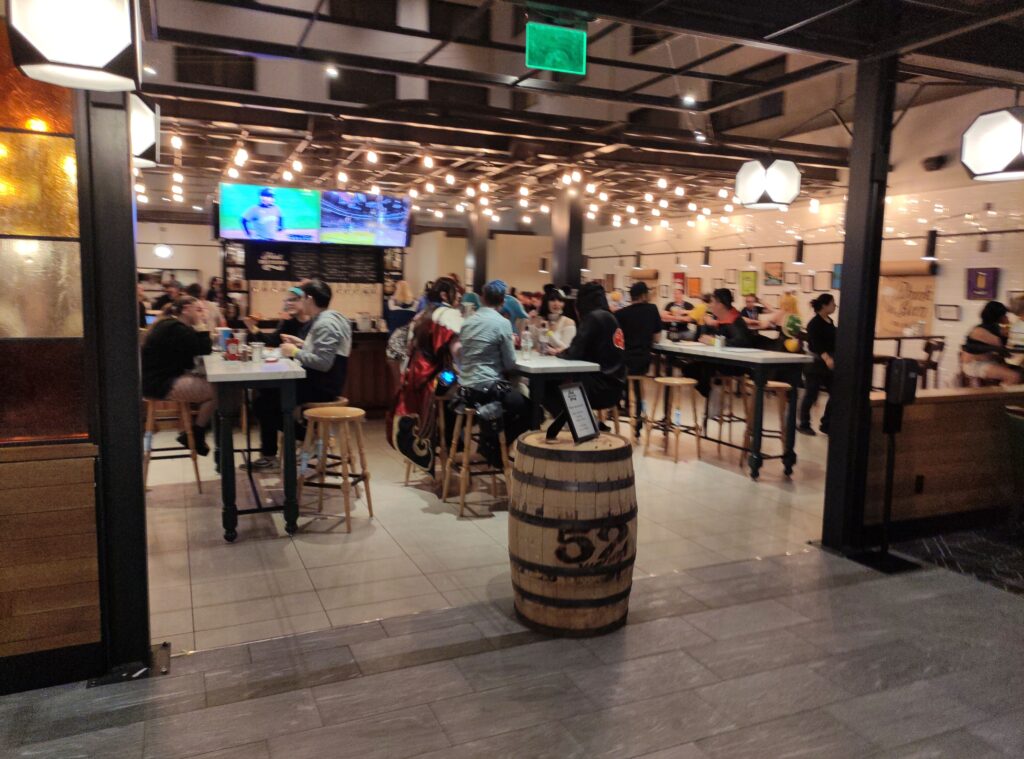
Eventually, when I was only a few minutes away from heading to my next event, the fire alarm went off! I’d heard jokes and grumblings about how somebody pulls the fire alarm at CoAF every year, but I mostly dismissed them on the grounds that people generally don’t act that juvenile. Evidently, that was wrong.
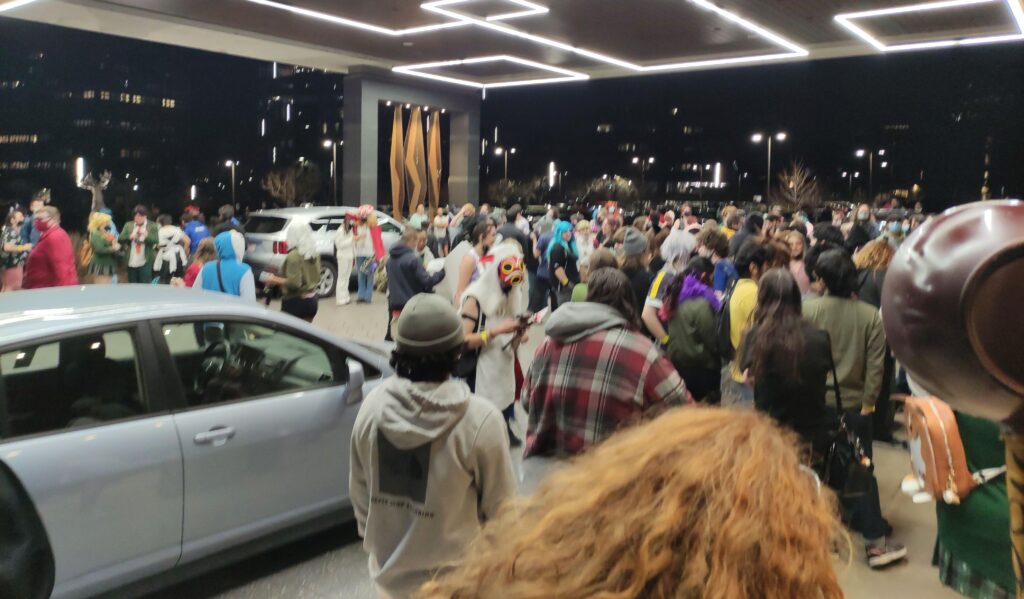
Having the whole convention (or what was left of it in the evening) evacuate to the hotel’s front yard did give me the opportunity to check out some more cosplays. I nearly considered asking for a photo with a few, but I didn’t end up seeing any character that I could recognize with 100% certainty, and I didn’t want to risk confusing anyone’s costume for another character.
After a 20-minute period standing in the brisk chill of a breezy Denver spring evening, a fire truck eventually showed up, to the applause of the crowd.
A few minutes after that, we were allowed back into the building. This didn’t end up being too much of a setback, although it did awkwardly mean that the hentai hallway had been evacuated and everybody going there needed to stand in one long, visible line to have their IDs checked and get back in. There was a chunk of time where the line was just standing still before the ID checkers arrived, but once the staff started checking IDs, the line moved quickly.
Saturday Panels: Hentai Quest Vanilla (10pm-11:30pm)
Alright, this was the last hentai event that I attended at CoAF, so if it’s not your cup of tea, don’t worry. And if you don’t want to read about a sexually explicit hentai game, then you should skip to the next section. But this… this is what I hoped for out of a hentai event at an anime convention!
The description for the panel read:
Hentai Quest Vanilla is a collaborative game where participants try and score with one of a handful of anime girls. Players join teams and roll dice in order to go on dates, fend off rivals, or take silly hentai quizzes. With success comes animated hentai clips and the chance to earn yummy Japanese snacks!
…and indeed, the panel was collaborative. The first thing the hosts did was split the audience into three teams of roughly equal size. They then put a game board on the projector that looked like it might have been coded from scratch. The board displayed the heroine that each team was pursuing, and kept track of points, dates, and other statistics.
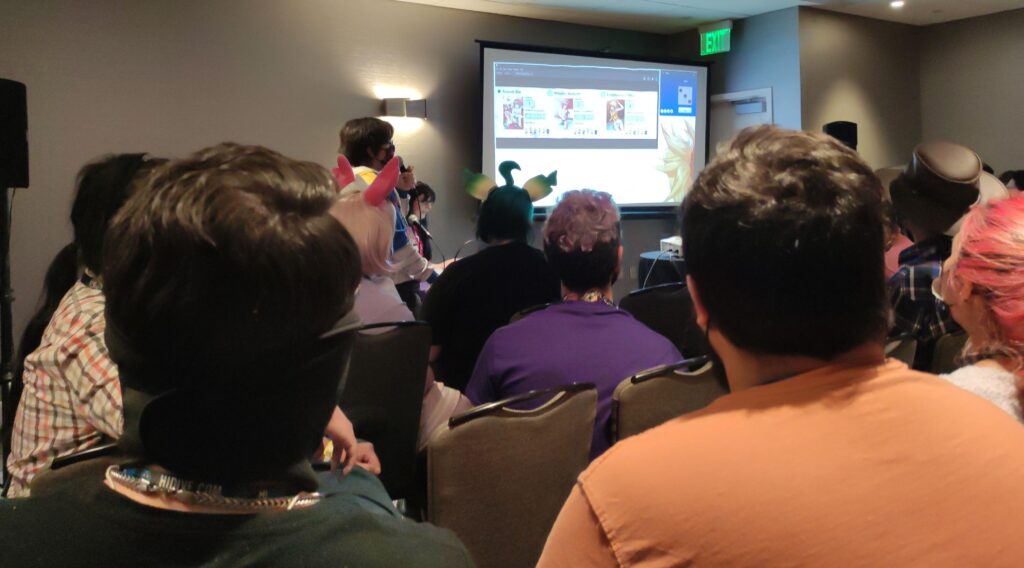
From there, the event was basically a game show. I want to lay out what the rules were, because it was an impressively fleshed out game. For every round, each team would send a representative to the front of the room. The representatives then took turns rolling dice that would determine what activity they had to complete. For each side of the die, the activities were:
- Date: The primary activity to advance the story of the game, this unlocks a scene read by the hosts detailing an attempted date with your team’s objective. Each date has a good ending and a bad ending; the team’s representative rolls the die again, with 1-3 earning the bad ending and 4-6 earning the good ending. The first team to successfully complete 16 dates wins!
- Rival: Another story-based activity, this unlocks a scene of lore regarding a confrontation between the protagonist and a love rival. Again, a die role determines whether the team defeats the rival, with 1-4 earning a failure and 5-6 earning a success.
- Care to fap?: The team must send a second representative to the stage to assist the first one. The two representatives turn back-to-back, and the hosts read the name of a fetish that can be found within hentai. The first representative holds up a thumbs-up or thumbs-down signifying if they’re into the fetish or not; the second one has to correctly guess their answer!
- Sex or no sex?: A hentai illustration mostly covered by mosaic censoring is shown on the projector. The representative (guided by their team) must determine if the image behind the mosaic shows active sex (with penetration) or not.
- Identification: A hentai illustration is shown with mosaic censoring covering only a strategic portion of the image. The representative (with help from their team) must determine what sexual act is being performed behind the mosaic section.
- Vocab: The representative must correctly explain the meaning of a hentai-related Japanese slang word (such as oppai, wakipai, or paizuri, to use three related examples.)
Activities 2-6 can earn a point for the team if completed successfully. The team needs at least 10 points on the board to progress through any of the last four dates. They can also spend points to bump up their dice rolls on date or rival activities (one point per die increment.) Also, whenever a representative successfully completes an activity for their team, they get to pick a Japanese sweet from a table on the stage.
If this all sounds a little raunchy, it’s because it was. The room was very lively. Teams were shouting out answers to help their representatives answer questions. Laughs were had and hentai knowledge was rewarded (“I’ve seen this one!” becoming a tagline when the censored images were shown.) Printed-out copies of the teams’ respective characters were passed around to mark the team’s current representative.
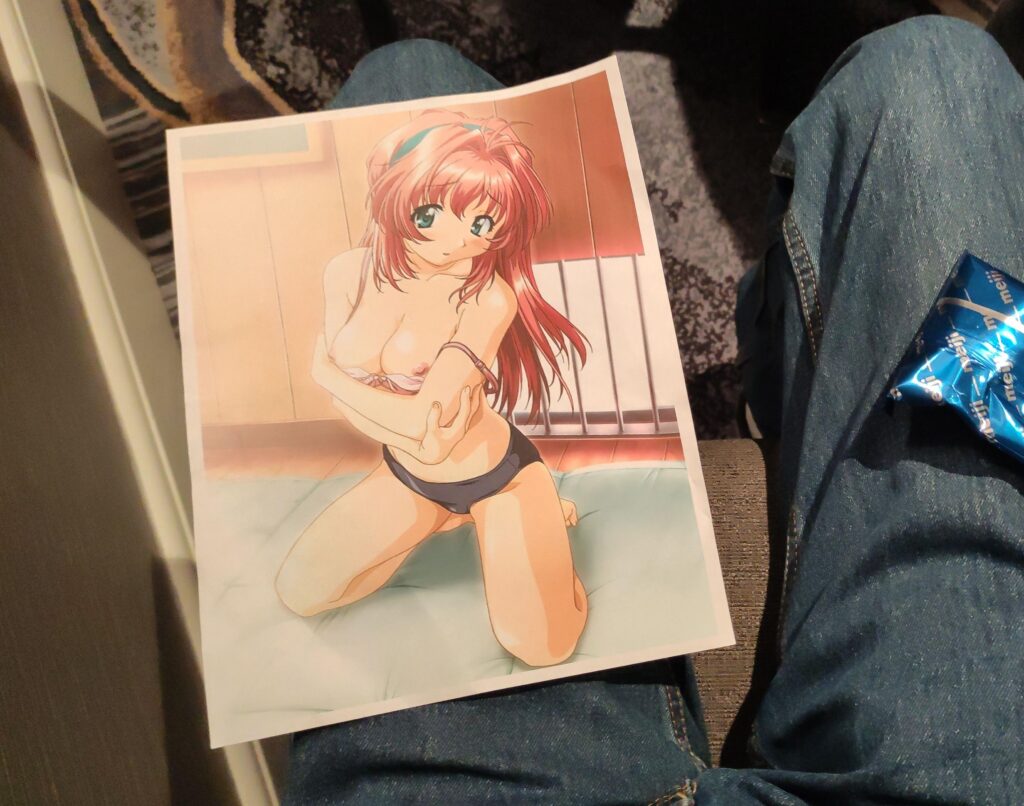
Between all the socializing, I actually found myself getting invested in the storyline. I realized halfway through that we were basically playing a visual novel in game show format! The only differences between this panel and an eroge were having 30+ people involved, and having the outcomes determined by skill (or luck) instead of choosing which option to click.
I didn’t take many pictures of the action out of respect for the rest of the room’s privacy, but I did earn two Meiji chocolates and three Hi-Chew rolls from my participation. I was also able to grab three flavors of Kasugai gummy candy on the way out at the end.
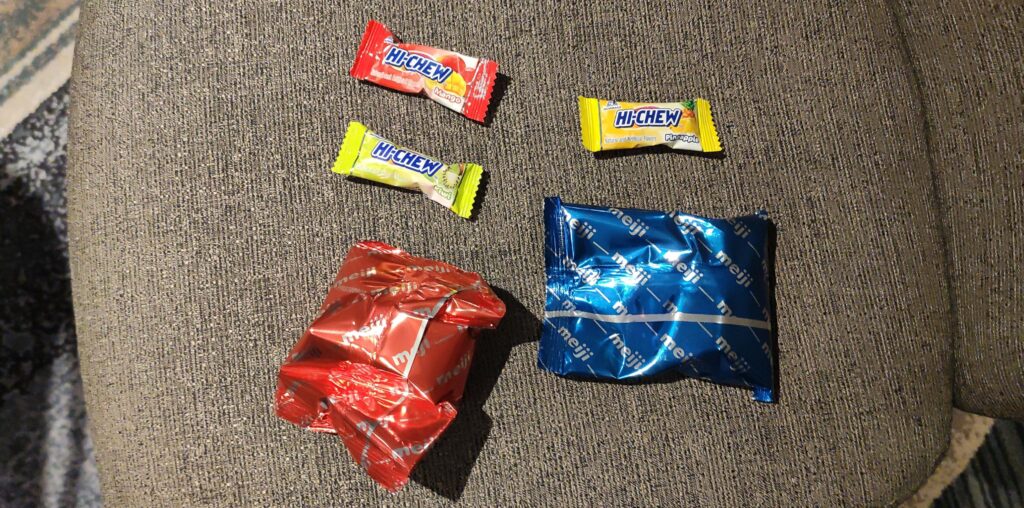
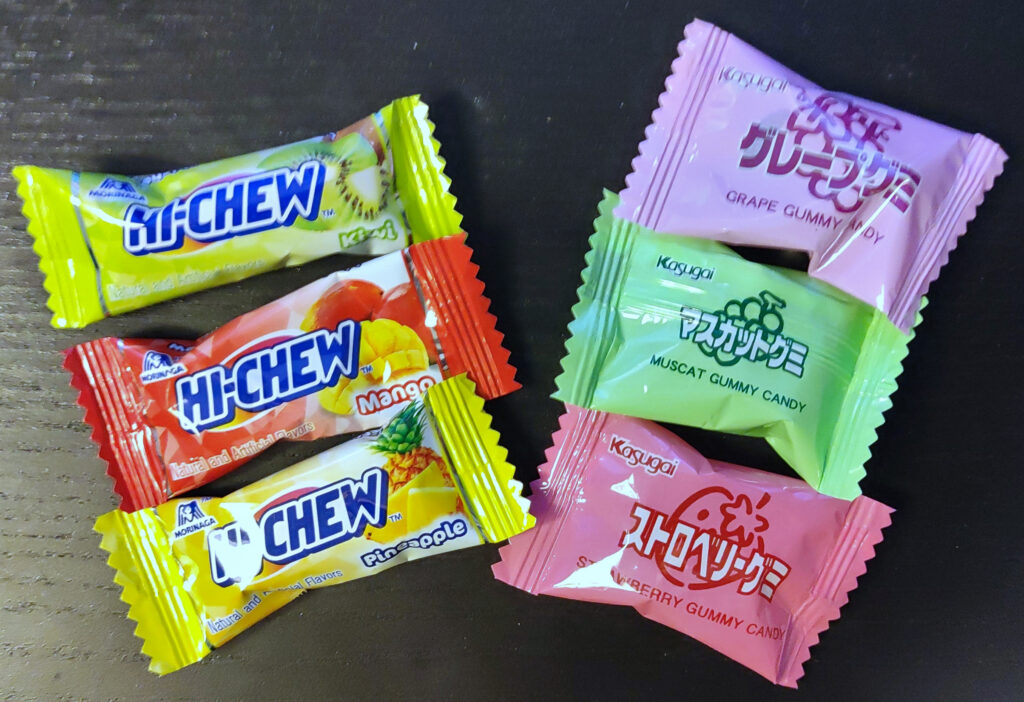
The panel actually ran long, partially due to the fire alarm incident, and we went about 20 minutes past the end of the scheduled time before we had to vacate the room for the next panel starting at midnight. My team (team #2) won with twelve dates completed; team #1 completed ten, and team #3 had only gotten through five because they kept getting the short end of the stick while rolling dice.
All in all, this was an event that was definitely worth attending. It was entertaining, it was interactive, it was competitive, and it felt like one of the most social events I got to be a part of the entire weekend. This was something that definitely would not have been possible at NDK with their adult content policy and after-hours programming limitations.
I unfortunately did not get the names of the organizers or their organization, but they mentioned they’d given a different Hentai Quest panel at another convention recently, so keep an eye out for them at other conventions too.
Saturday: CODE:APEX Rave
I ended the day off with something I’d been toying with the idea of attending, a “rave.” Most conventions that fall under the themes of gaming or anime have one of these, although I’d only heard them joked about and had never attended one myself.
I sort of surprised myself by going to this, and it was also kind of a challenge to myself. I usually don’t enjoy loud or crowded places. I can’t explain exactly what made me want to try this out, but it had something to do with the elephant in the room of me attending a convention: being there alone.
“You need to get out more.” “You should be less afraid of talking to people.” “You can’t be so prudish in this day and age.” “You won’t find anyone to connect with playing things safe all the time.” All of these are sentiments that I’ve had pressed on me, either directly or metaphorically, over the last five or more years of my life. There’s never anything wrong with the world, it’s always something wrong with me; thinking otherwise is supposedly delusional, or at best, unhelpful.
Going to a rave is something I normally wouldn’t do. So this time, I felt an urge to do it. It almost felt like self-destructive behavior, in a sense. I wasn’t entirely comfortable walking into this situation, and I had absolutely no idea what to expect, just some fantasy best cases and some dully outlined worst cases.
As one might expect, the reality ended up being dead in the middle, within the “ordinary” zone.
I located the rave in the main events room behind the lobby of the hotel (just next to the video game room.) In the back, a row of dark tables with A/V equipment were manned by convention staff. In the front, a stage flanked by large speakers housed a DJ table and several professional dancers. In between, a mob of convention attendees formed a dance floor, becoming increasingly dense moving from back to front.
The music wasn’t bad, although it was way too loud (if I ever attend a rave again, I’m going to bring earplugs, just like I do with concerts.) When I first entered, I sat down in a row of chairs against the back wall near the entrance to scope out the scene. After taking a picture or two, I decided it was then or never, and got up to join the crowd.
It took a lot of guts to actually start dancing, but I was able to push through it because I knew the secret: nobody was looking at me, everyone was doing the same thing I was. The room mostly consisted of groups of two to four people attending together, most minding their own business within the grand scheme of things.

That’s not to say there was no interaction at all. A few times in the hours I was there, a train of people (sort of like a simplified conga line) started running in a circle near the front, which I sometimes joined into if I could manage to hop in when it formed. From time to time, I’d see an adventurous guy try to approach one of the girls as a temporary dancing partner, with mixed success. I had one girl come up to me and offer a glow stick, pictured above.
Perhaps the strangest interaction I had was when a couple of boys approached me and one shouted over the music to ask if I liked Zelda. Being vaguely familiar with Zelda from second-hand gaming talk and a few YouTube videos (mostly speedrun explanations), I was at least confident I knew the very basics (e.g. the fact that the player’s character is named Link, while Zelda is the princess he’s trying to save), so I picked what I thought was the safe answer of “yes.” The next question: “Oh yeah, what’s your favorite Zelda game?” Having been cornered out of that line of conversation, I tried to remain as casual as possible while throwing out an explanation that I don’t really play video games and I’d never actually played any Zelda myself, so I don’t have a favorite. The guy who’d inquired looked disappointed, but left me alone after an “oh, okay,” thankfully not pressing into an altercation.
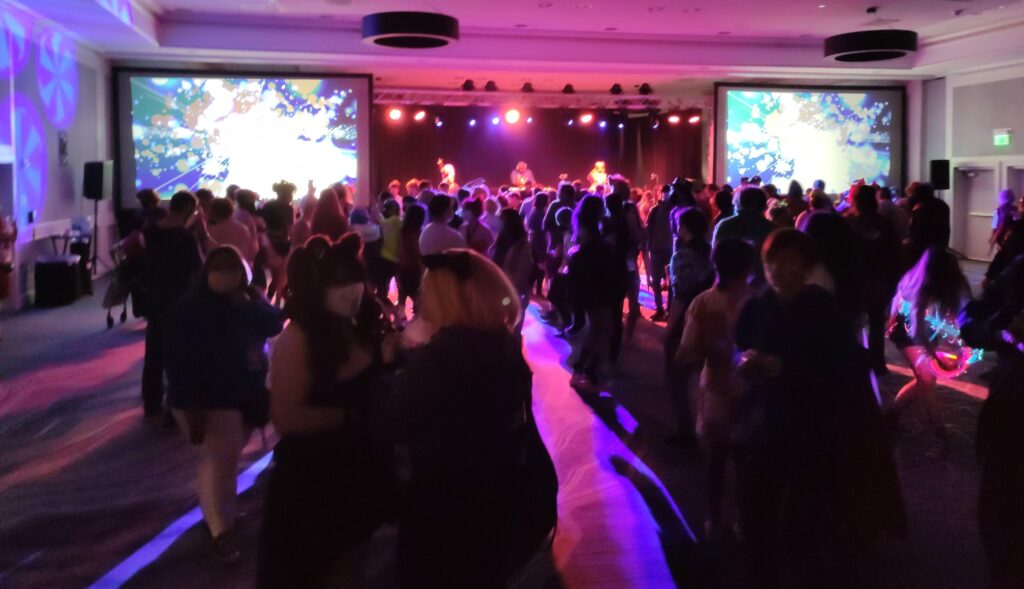
The music was fast, and the dancing was tiring. I ran out of breath and had to take a break in the chairs to let my heartbeat recover several times. I was one of the only people who kept my mask on in the room (the convention’s COVID policy did not have any exceptions for the rave), and looking around, I was in the minority with wearing jeans, too; many of the participants were wearing athletic shorts, with a few girls sporting skimpy bunny outfits that I’m pretty sure wouldn’t have met the convention’s decency policy for costumes.
There were water jugs and paper cups lined up along the wall nearest to the entrance, which I took advantage of several times. During one of my water breaks, I was personally approached the only other time that night by a girl with a small group who’d found a prescription medication container on the ground and were seeking out the owner.
Eventually, my night was cut an hour short by an injury; someone behind me accidentally stepped on the back of my ankle while we were both jumping, and it felt bad enough to immediately leave the dance floor and sit down. After waiting a few minutes, it didn’t seem like it was going to recover immediately, and I didn’t want to risk hurting myself worse by continuing to jump on it, so I left.

I reflected on the night during the quiet walk back to the parking garage. The walk was interrupted once by a homeless person just out of the frame in the above shot, who thought I was trying to take a picture of them (Denver sure rocks, doesn’t it?)
The rave really amplified what I’d felt about attending the convention itself. It was a place where other people could have fun, and where I could blend in while cutting loose too. But at the end of the night, I hadn’t had any meaningful conversations with anyone. I was still going home alone, I was still going to wake up alone the next day, and once the convention was over, I wouldn’t have anyone in particular to reminisce about it with.
“Look, but don’t touch.” “You can have conversations with us, but don’t make it weird by trying to stay in contact afterwards.” When I attended NDK, I was so nervous about going to a convention by myself for the first time that I didn’t mind when people left me alone– I was just happy to have accomplished the experience of attending. But at CoAF, I already knew I was capable of flying under the radar, walking to panels, and picking out merch. With that not being a significant undertaking anymore, I ended up becoming more in tune with how other people were spending the convention compared to myself. Ultimately, I concluded, maybe there’s not much point to attending conventions if you’re not sharing the experience with others– there’s nothing special about standing next to random people, what’s special is being with people you care about.
After arriving back at the parking garage, I found its exit propped open. If I’d taken a regular ticket, I could have just driven out (although there happened to be some sort of police officer or security guard nearby in the garage.) Since I’d put my credit card in as my ticket earlier, I knew they’d have it on file, so it was better to just accept the normal charge rather than risk being billed for indefinite time.
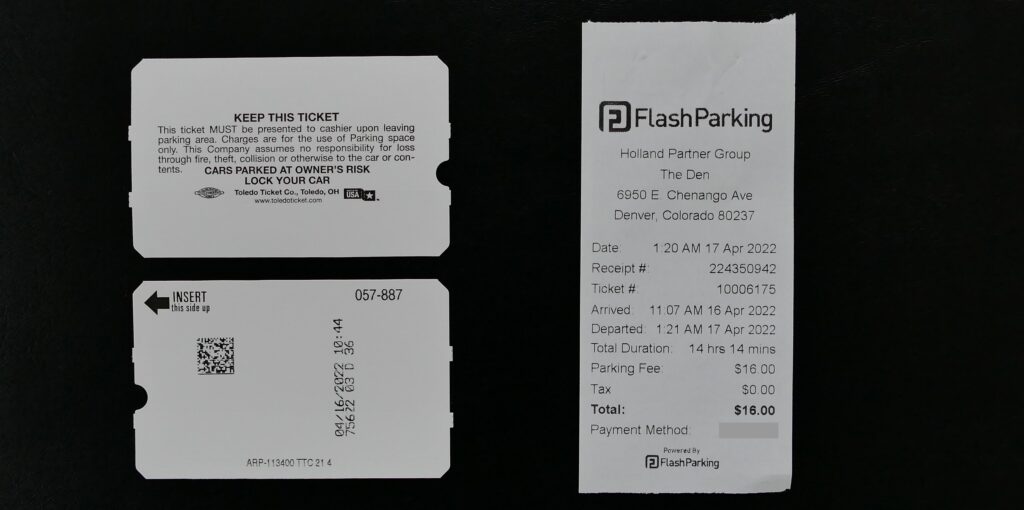
Arriving home again, far later than any grocery stores or restaurants were still open (thanks Denver), I went straight to sleep and planned to try for an earlier start the next day.
Sunday Panels: Japanese Exchange and Teaching (JET) Program (10am-10:45am)
Sunday, I got to the convention again with plenty of time before the first panel at 10am. I got a free parking space at the hotel this time, stopped by the manga room to take a couple of pictures while it was empty (and ran into Kelly and Marcus again in there), then headed to the second and last JET program panel of the weekend.
For those unaware, the JET program (short for Japanese Exchange and Teaching) is a Japanese government-organized exchange program primarily for bringing native English speakers into the country as temporary English teachers. I had heard of the JET program before, but hadn’t seriously considered it because I’m not a professionally trained teacher.
The panel was nearly empty, which was a big surprise to me– I would have thought lots of people going to an anime convention would be interested in ways to work and live in Japan. The same panel had one showing on Saturday, which I assume had higher attendance since Saturday was the most eventful and most popular day of the convention.
I’m very glad I attended this panel. The two girls giving the panel were former JET program participants (known colloquially as JETs), and they sold the program very well with an informative presentation. I knew that JET had to do with teaching English in Japan, but I didn’t realize that a lot of the private English teaching companies in Japan are not affiliated with JET– JET is a very specific program operated in cooperation with the Japanese government, while the private tutoring companies I was more familiar with (and had heard horror stories of) operate in the private sector separately from JET. JETs who teach English are typically placed in public Japanese schools as assistant teachers, ranging through all ages of the Japanese public education system.
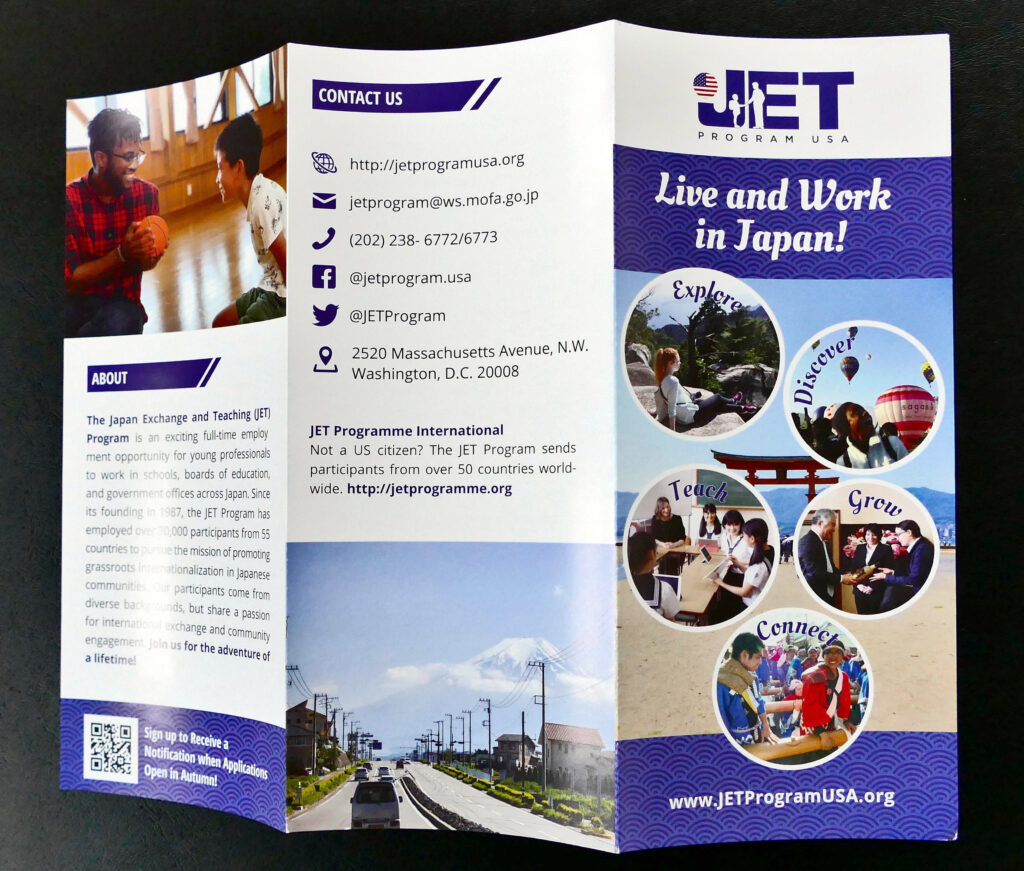
Unlike the private tutoring companies that tend to be clustered in city centers, it sounded like it’s statistically common for JETs to be placed in more rural areas (schools in smaller cities or towns may be in greater need of English teachers, partly due to not having access to those tutoring companies.) The presenters had been placed in two different settings, which made for a great comparison. I didn’t write down the locations, but I believe one was sent west to Nagano while the other was sent north to Fukushima.
Another thing I learned was that JET isn’t just for English teaching. 90% of JET participants are placed as assistant language teachers (ALTs), with a very small number getting an elusive sports education advisor (SEA) position, but some JETs are placed as coordinators for international relations (CIRs). Being a CIR consists of translating official documents, interpreting for official guests or local foreign residents, and giving public English lessons or cultural lectures. Unlike the teaching positions, which focus on strong English knowledge and teaching skills, the CIR position also requires strong knowledge of the Japanese language.
The JET program is only a short-term activity; the initial placement is for one year, and strong performers are often renewed for up to three years, with an absolute maximum of five years allowed on the JET program’s visa (except for when Japan closed its borders due to COVID, during which time they extended some JETs for a sixth year because they’d otherwise have no native-speaking English teachers.) Japan wants to send JETs home with cultural knowledge and stories of Japan to expand Japan’s international reputation and spur tourism interest. But the panelists had several stories of participants who’d stayed in Japan longer, either by qualifying for another work visa (which is what I’d probably aim for) or by finding a Japanese spouse (easier said than done, obviously.)
I’m not sure how well I’d fit in as an ALT, since I have tutored children in the past (including English as a subject) but I don’t have formal teaching training and I haven’t had much experience with kids in the last few years. Truth be told, I’d certainly give it a try and I think I could adapt if I made it into the program, but doing things like tutoring as a side job to gain experience before applying isn’t something I have much interest in right now. The CIR position sounded more interesting to me, and it sounds like it’s less competitive since it requires Japanese fluency (prospective JETs applying as ALTs are sometimes solicited to switch to CIR if they have Japanese knowledge), but while I’m learning Japanese as rapidly as I can in preparation for the JLPT N2 later this year, I’m not sure if I’d have the level of competency that they’re looking for by the time of the interview.
Still, this panel got me considering JET as a serious option where I’d previously written it off. It included a lot of first-hand personal experiences about daily life in Japan, almost what I’d been expecting at the previous day’s tour company panel. It certainly reaffirmed my desire to keep learning Japanese and keep working towards ways to experience Japan for myself.
Sunday Panels: Anime Collecting Then and Now (11:30am-12:30pm)
The next panel I went to was a look at how being an anime fan was different in the 90’s compared with today. It primarily focused on collecting anime itself as well as anime merchandise, but also touched on the experience and importance of conventions and how they’ve changed.
This was a very interesting panel to me. I wish it’d been a bit longer, because I had a couple of questions that I would have enjoyed hearing the presenters’ takes on. Back in the 80’s and 90’s, the internet wasn’t widespread, and anime was primarily distributed through VHS tapes, or later DVDs. Some shows were distributed one or two episodes at a time (since that was all that could fit on a VHS tape anyway), with home video stores forming a precarious shipping network where a bankruptcy could mean not seeing the next episode. The subs vs. dubs debate was actually important and not just a matter of personal preference, since the store had to decide how many of each version to order and you had to decide which version to buy.
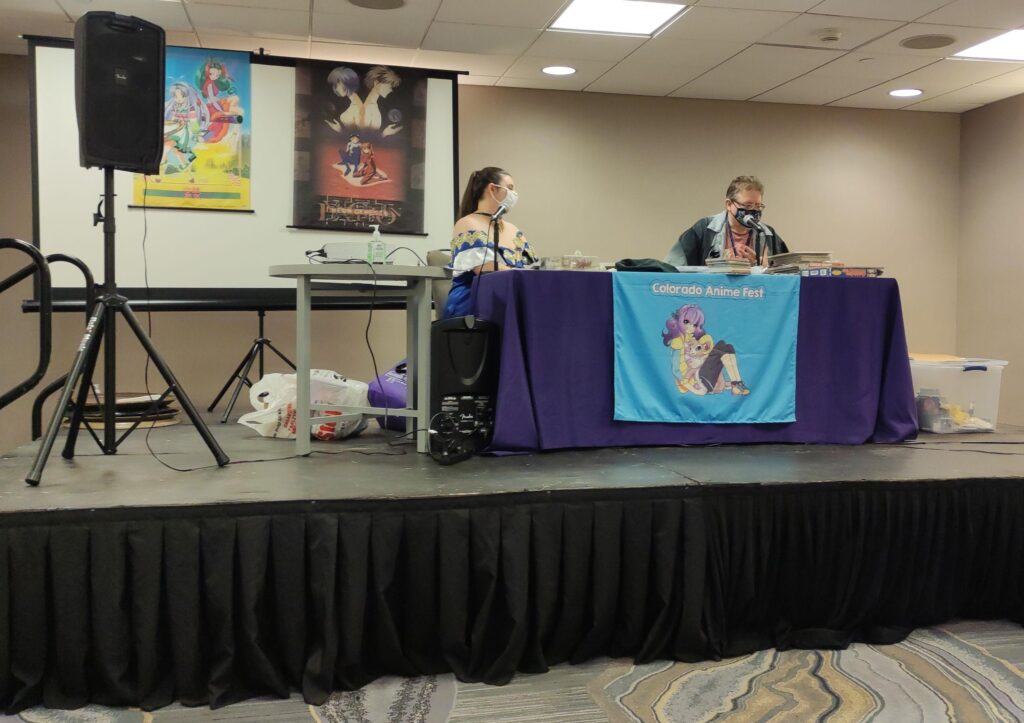
The presenters’ main point was that anime and anime merchandise have both become far easier to access than they used to be, and the experience of being an anime fan is both less difficult and less social than it once was. People used to connect with each other while browsing the shelves, then they’d trade or borrow tapes and discs. Now, the vast majority of anime can be found online through mega-corporate collections such as Crunchyroll and Funimation, not to mention an even wider selection can be found for free through pirating websites. (Even pirating has become less social, since physical bootleg creators and distributors have been replaced by faceless servers and torrent trackers.)
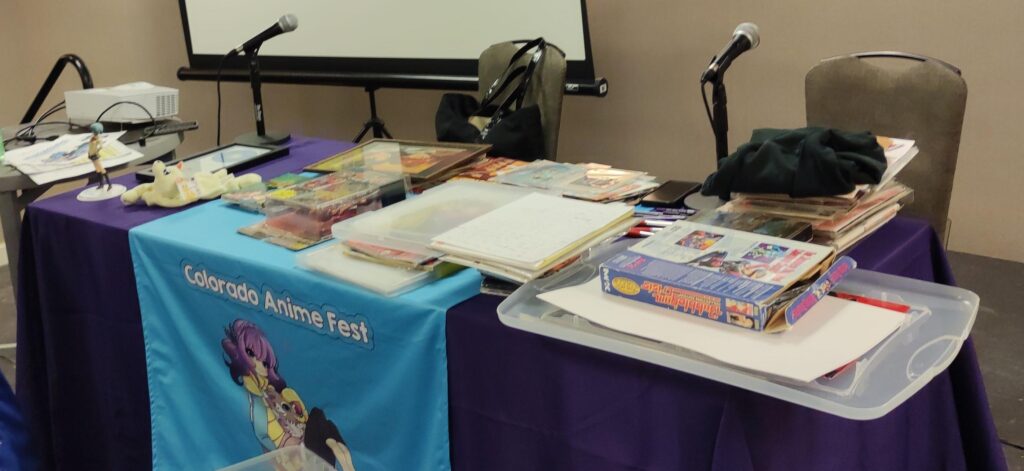
At one point, the main presenter reminisced about “going on the hunt” for a season of a show or a particular piece of merchandise that he’d seen in a magazine and wanted. The reason this interested me so much was because over the last few years of being an anime fan, I’ve felt like I was going on a “hunt” myself– only doing so online. A big example of this was when I purchased a dakimakura cover created by a Japanese artist (I’ve had a blog post about that experience in progress for a while), since daki covers are usually limited-run and only sold first-hand at Japanese conventions (being distributed from there by resellers on Japanese-language auction websites.) There was also the time when I had to trawl through forums for an unofficial English language patch for the Chaos;Head visual novel, which I then had to set up a Windows XP virtual machine to play on the Flowchart Kings show.
The presenters were absolutely right that these experiences aren’t as social as they used to be, but I was intrigued to hear him describe the same “hunt” that I’d felt, and I was interested to know if they’d consider what I was thinking of similar in any way to having to physically try different stores or travel to a specific convention looking for something.

The panelists were handing out historic anime merchandise to people asking good questions. Marcus and Kelly were in front of me taking press photos of this panel, and they managed to score some. I raised my hand, but didn’t get to ask a question before the panel ended, although I still got a ballpoint pen that the panelists were giving out. The panelists founded and still run their own anime convention called Black Hills Con in Rapid City, South Dakota, and had stories of some of the people they’ve met from there (I believe the panelists, who were married, also said they’d first met at an anime convention.)
Sunday: Exhibitors’ Hall
Speaking of merchandise, I haven’t talked about the merch at Colorado Anime Fest yet. I didn’t purchase the official convention T-shirt in advance, this being my first time attending (and thus not sure if I wanted to provide additional financial support to the convention, especially with their COVID policy); instead, I once again saved my money to pick out something anime-related for myself. I ended up making purchases on early Friday afternoon and early Sunday morning, both from the same booth.
The CoAF Exhibitors’ Hall was technically split up into two sections, Artists’ Alley and the Vendors’ Hall, similar to NDK. The big difference was that instead of being physically separated by fifty feet and a wall, the two sections were in the same room and incredibly close together. The vendors occupied a few rows of booths in the middle of the room, while the independent artists were lined up along three of the walls (with the fourth wall being reserved for an administrative table and the autograph area.)
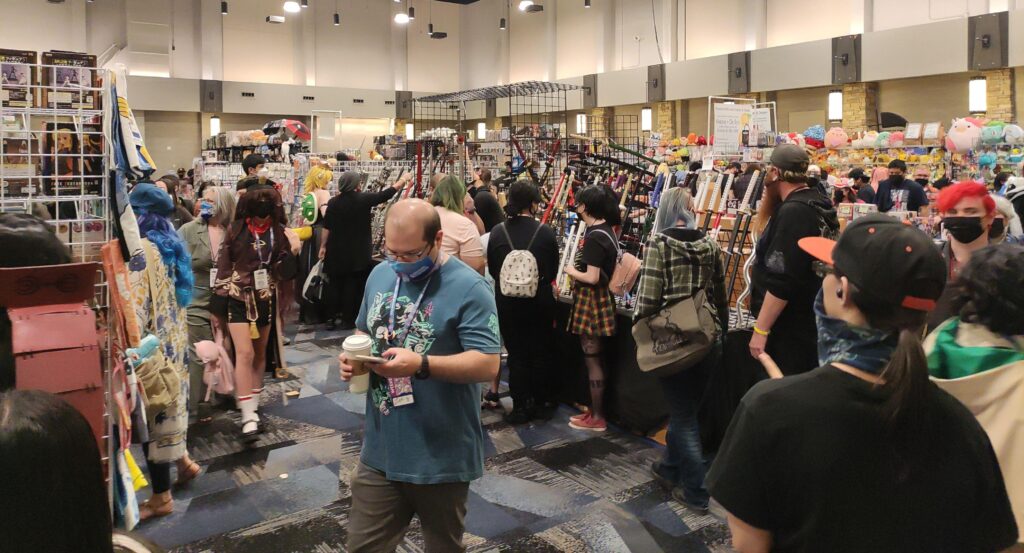
I’m not going to pull punches here; the exhibitors’ hall at CoAF was the most disappointing part of the convention. At NDK, I kept walking through the exhibition floor because there was a huge, diverse range of cool and beautiful anime merch– figures, posters, DVDs, books, wall scrolls, pillows, T-shirts, you name it. The entire exhibition hall at CoAF was probably less than half the size of just the artist’s alley portion of the NDK exhibition hall. I counted only two vendor booths displaying figures for sale. I didn’t see much in the way of actual DVDs, Blu-rays, manga, or light novels. The selection seemed to be mostly clothing, accessories, and trinkets such as plushies or stickers.
I don’t want to bag on any artists, but most of the ones in attendance weren’t to my personal taste, either. There was one notable exception: Tiribrush, one of the artists I’d seen at NDK and been heavily tempted to purchase from, was back at CoAF.
In particular, I’d actually gone online to consider ordering her Monika portrait from her Etsy store, but they’d sold out at NDK and hadn’t gone back into stock until CoAF. Not only did she have that item again, but when I went to check her Etsy store upon seeing her on the CoAF exhibitor list, I saw she’d recently added a portrait of Ceres Fauna (a VTuber) from Hololive EN Council.

I knew I wanted some artwork from Tiri, but I wasn’t sure exactly which ones I wanted (besides the Monika print I’d eyed last time.) I started off on Friday with a set of 3 (she was selling 1 for $15 or 3 for $30), choosing Monika, Chika from Kaguya-sama: Love is War, and a group picture of Darkness, Megumin, and Aqua from Konosuba. I waited on a fourth in case I saw any prints from other artists I could use to complete a rectangular set of four; but after nothing else caught my attention over the next two days, I asked if she still had Fauna in stock on Sunday, and she did.
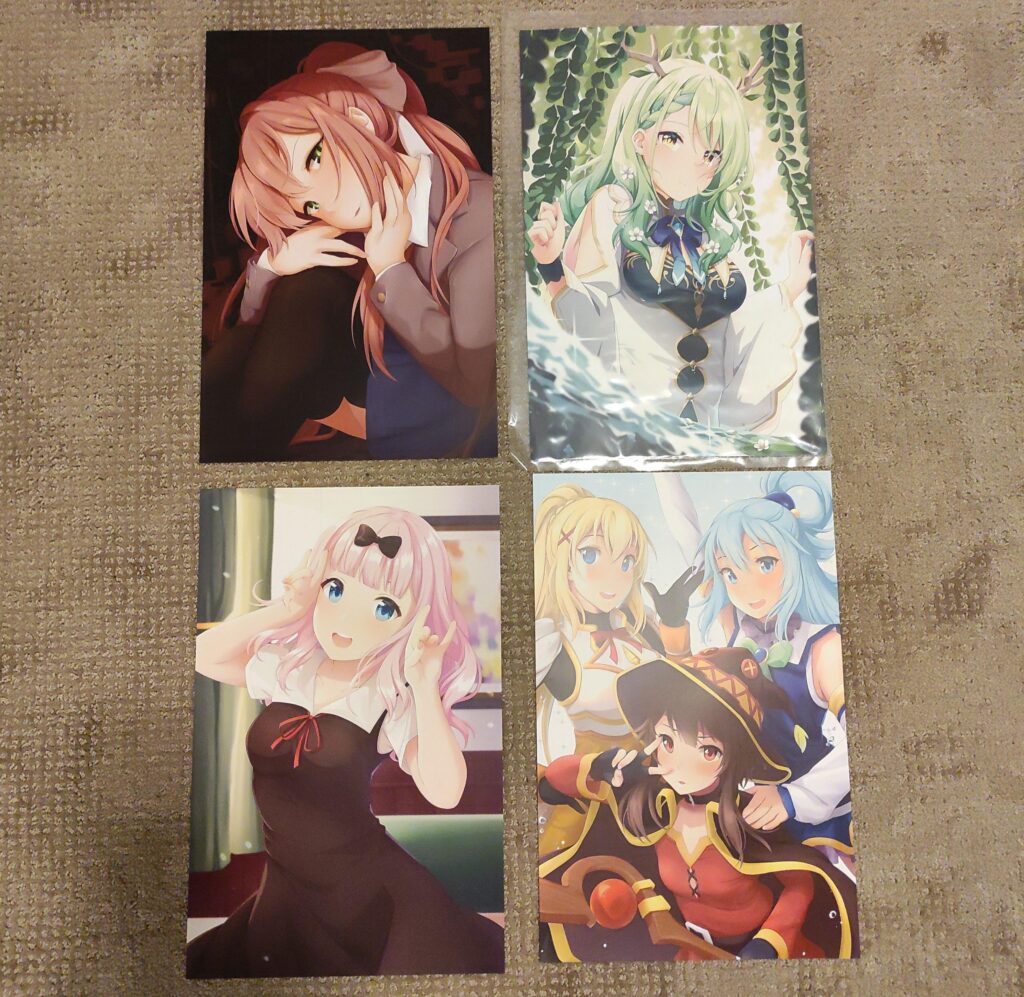
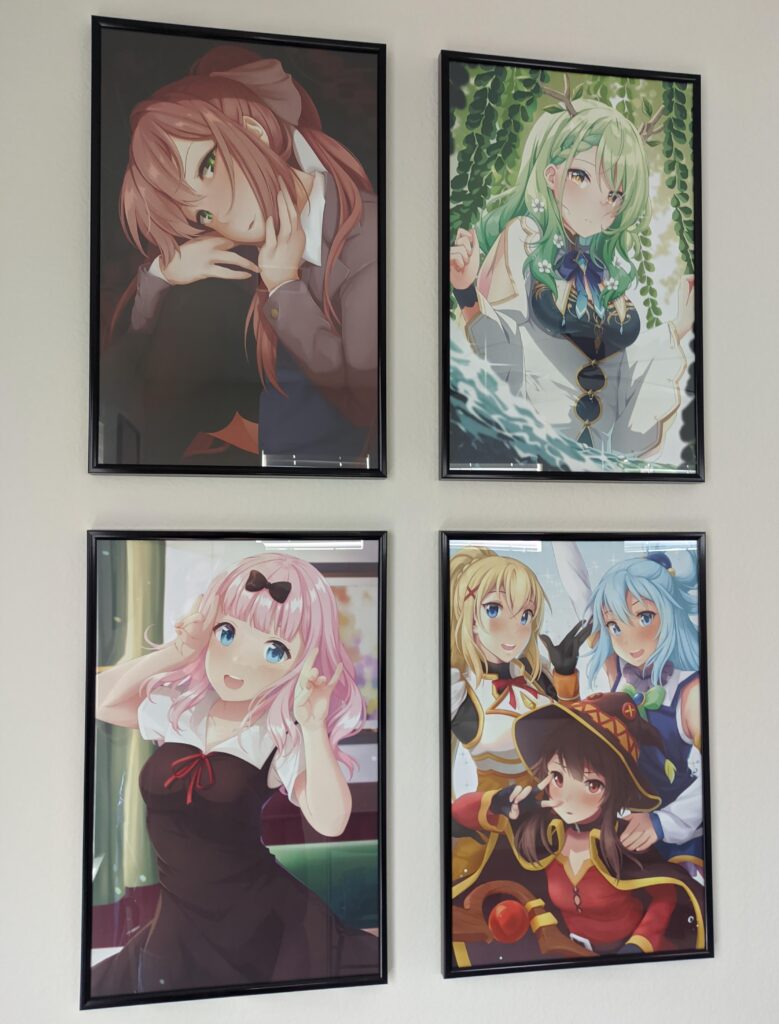
I’ve now got the prints framed and hanging on my wall, and they’re great to look at every day! Overall, the exhibitors’ hall was both small and crowded; walking through it took a long time not because there was a lot to see, but because I had to shuffle-walk within the snake of attendees trying to make their way through the booths. Despite that, I’m glad CoAF was large enough to attract Tiri back to Denver, and I’m very happy with these prints to remember the weekend by.
Sunday Panels: Writing for Anime with Laura Stahl (1pm-2pm)
The last panel I went to was another about writing; again, I wasn’t looking for any particular guidance, but I enjoy writing from time to time, and I usually don’t mind hearing about techniques that work for other people. This time, though, I was a little off, because this panel wasn’t about writing anime from scratch, it was about writing anime dubs.
Dubs are the voiced translations of anime that non-Japanese people watch if they want to listen to the dialogue in their own language. I’ve always preferred subs (short for subtitles), written translations that are displayed over the video while the original Japanese voice track is playing. I didn’t know who Laura Stahl was going into this panel (even though she was one of the convention’s special guests), but she’s been a voice actress in dozens of English anime dubs (as well as a few video games); in the realm of shows I know, she played Setsuna in the English dub of Love Live! Nijigasaki High School Idol Club, as well as Clarence in Sword Art Online Alternative: Gun Gale Online. She’s also worked on writing for some dubs, eventually working her way up to directing for them.
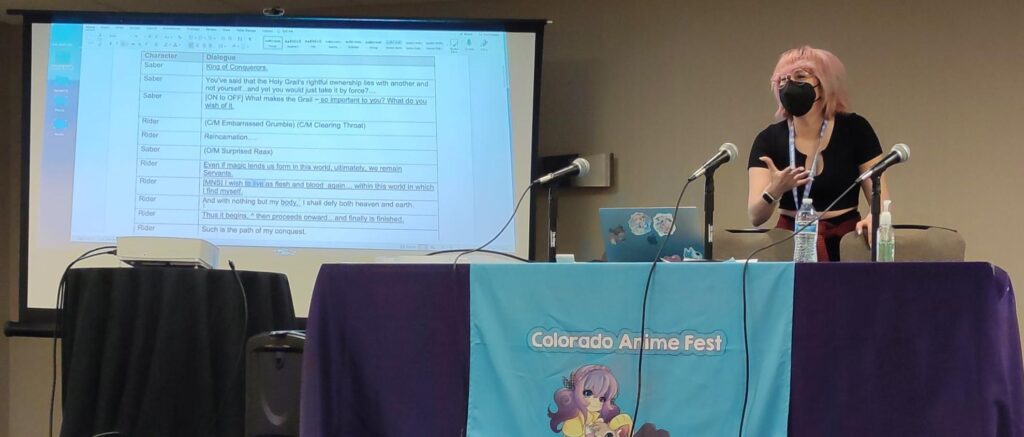
I was already familiar with some of the basic reasons why dubs end up sounding as awkward as they do sometimes: the characters are animated to their Japanese speech, and the English voice actors have to match the movement of their mouths as closely as possible. But I hadn’t actually thought about how much time and consideration went into the writing of the English lines.
Laura’s worked with a variety of Japanese anime studios, and the experience is different for each of them; some basically provide their own translations that the dubs are required to use, while others provide a Japanese script and give the dub writers free reign to adapt them, with the middle ground falling in between with a medium amount of oversight. Different studios have different standards for how closely sounds have to match visual mouth movement.
Laura showed a couple samples of dubs that she’d helped write; the process involved having the original Japanese lines in writing, sometimes having an interpretation of that line to clarify the intent behind it, having the timestamps for when the line starts and ends, and having notes about any special sounds or movements the character’s making before, during, or after the line.
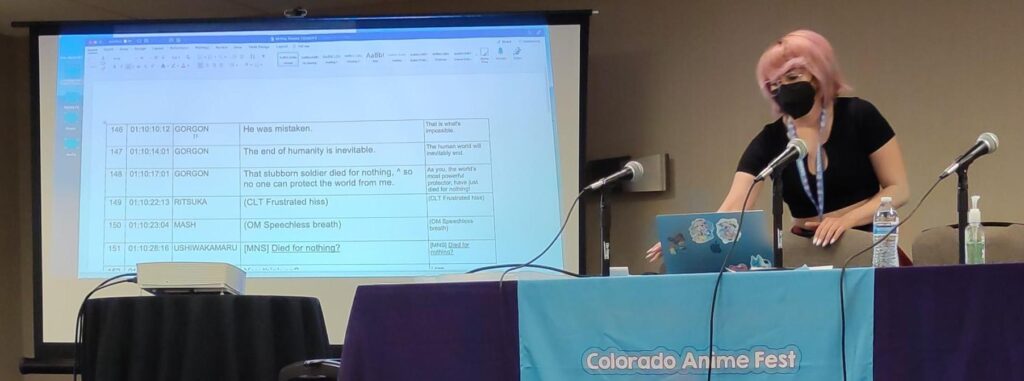
In addition to just translating the lines, sometimes larger changes are needed to convey a message in a way that a western audience will connect with. That practice has to be balanced with the need to keep characterization intact. For example, a stereotypically rural Japanese character might use esoteric speech patterns and make obscure Japanese cultural references that Americans wouldn’t understand, so in a dub, they might instead be given a stereotypically rural American accent like a southern or western accent and make cultural references that Americans would understand as being rural.
I’m still going to prefer subs over dubs, but hearing about the consideration that goes into adapting an anime script between languages gave me a new appreciation for dubs that I wouldn’t have otherwise had.
Sunday: Tabletop Gaming Room
At this point, I was tentatively planning to attend a panel about the history of Japanese food in America about an hour later, and between then, I was going to sit down in the lobby and work on this blog post from my phone some more. Before doing that, I decided to walk through the venue one last time, and in particular, I wanted to take a quick look at the tabletop gaming room.
A year or two ago, a tabletop gaming attraction wouldn’t have even caught my interest, let alone been something I was comfortable approaching. But I’ve been playing board games with the Rocky Mountain Geeks meetup group for a while now, and I’ve gotten fairly competent at learning new games. (In fact, I tend to get drawn into heavy Euro games at parties, since I have the patience to learn their mechanics.) The big trick for me with board games is separating the theme and story from the actual rules and mechanics; once you do that, games that once looked completely different from each other end up having a lot in common, and they become much less daunting.
The tabletop gaming room is another CoAF exclusive (NDK did not have one.) It took some time for me to find– it was all the way in the exterior corner of the venue, opposite from the panels and near the exhibitors’ hall and the bar. When I eventually located it, I almost passed it, because it was actually two rooms, and both were nearly empty.
The first room had what looked like half of a bookshelf filled with games, and one CoAF staff member talking to a couple of attendees. The second room was larger, and had a few tables and chairs spread out from each other. Having seen what I came there to see, I turned around and started walking back to the lobby– but as I was walking, I was contemplating that the one small group I’d seen in the second room looked familiar to me.
The three men and one woman in the tabletop gaming room had been in the audience with me at the Hentai Quest gameshow panel the night before– in fact, we were on the same team! I’d been sitting right behind them conversing about quiz answers, and while some of the room eventually left partway through the game, these four were among those who stayed until the end.
Still walking back to the lobby, I had a decision to make. I could either sit down, work on my blog post, and attend the food panel later; or I could take a chance actually talking to some people for once. It’s hard to express how nervous I was about walking up to strangers and introducing myself (after all, they might not have even been who I thought they were), but ultimately, I knew that if I didn’t do this, I’d just regret it. So I turned myself around, walked back to the tabletop gaming room, and entered.
“Hey, was I sitting next to you guys at that thing last night?,” I discreetly started. They smiled and confirmed that they did indeed remember me, and after introducing myself, I asked what game they were setting up and if I could hop in to join them.
They happened to be unwrapping a brand new copy of Sentinels of the Multiverse that they’d found in the CoAF library (both a recent edition and an expansion pack in a separate box.) I’d actually played Sentinels once before at a Rocky Mountain Geeks meet-up when a newcomer had brought it to a gathering at Mythic Games. I’d been one of only a few people willing to try it out, but now I was able to help teach it at CoAF.
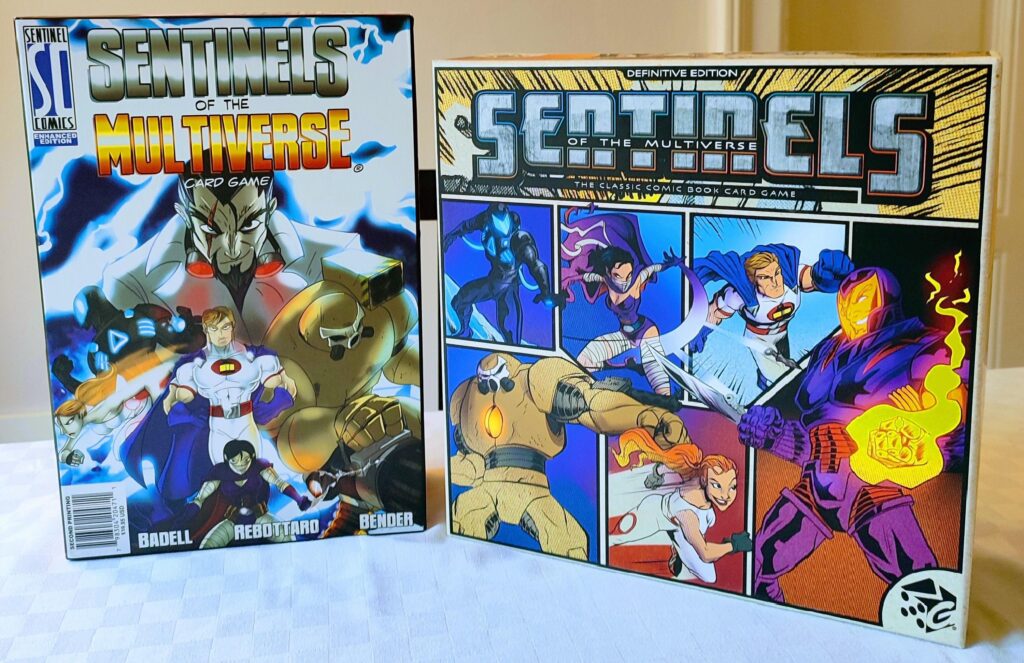
Sentinels is a comic book-themed card game (featuring original characters inspired by Marvel and DC comics) where players build decks of heroes and work together to fight a villain trying to destroy the city (with the villain’s henchmen and actions determined by chance and card mechanics.) We chose a medium-difficulty villain, and it did not go well for us– we only made a dent in the villain before she managed to build up an army, and we then had to start expending resources to protect and revive each other. We eventually lost, but it was a long fight.
Next, we played Coup, a simpler card game one of the others (going by the name Dee) taught where players bluff about their hands to collect each other’s money and influence (if a player with the wrong defensive card calls your bluff, then you can lose cards, money, or influence instead.) Sometime during these two games, I made a silent decision to skip the food panel and continue playing instead.
While we were playing, CoAF’s COVID policy made itself apparent for a third time that weekend. The other three hadn’t been wearing masks when I first sat down. I kept mine on for a while, but when the others started to eat snacks, I went ahead and took mine off (turning down a polite offer for snacks.) A bit later, one of the group warned that they’d seen a CoAF staff member eyeing our group from the hallway, and I put my mask back on; a few minutes after that, the staff member came in and “reminded” us to wear our masks whenever we’re not eating or drinking.
Eventually, it was getting close to time for the closing ceremonies, and I was glad it sounded like the group was planning to go to those rather than skip them (because I didn’t want to have to decide whether to excuse myself for them or keep playing board games.) The whole duration of our playing, there was only one time when any other attendees entered the room, a quiet group of two who played a quick game and then left.
As we packed the cards back up and the group separated to return the games to the other room and pick up some drinks from the bar outside, I worked up the nerve to ask Dee, who seemed to be an informal leader of the group (and was one of the only ones still standing there, in any case), if he wanted to exchange numbers to keep in touch about board game events. He hadn’t heard of Geek Out Cafe or Enchanted Grounds, but had apparently participated in tournaments at Mythic. His phone was apparently out of battery at the time, but he gave me his number and told me to text him with my name for later.
I haven’t had an occasion to talk to Dee again since CoAF, and I regret not sticking around for a minute or two longer to get numbers from Nate and Josh, one of whom had expressed interest in cosplaying at NDK later in the year. I didn’t even remember the woman’s name long enough to write it down after the convention. It truly took everything that I had to introduce myself to strangers and ask even one of them for their contact information, so my social energy was just about drained as I was heading to the closing ceremonies.
Still, even if I have a long way to go before I find what I’m looking for in life, this was an encouraging experience for me. Before NDK, I wouldn’t have had the guts to ask to join someone’s group in an activity. This was evidence that pushing myself to go to that first convention alone, and pushing myself to attend multiple meetups regularly and talk to new people in public, have gotten me at least a little more capable of socializing. I just hope my progress isn’t too slow to ultimately matter.
Sunday Panels: Closing Ceremonies (5pm-6pm)
I attended the closing ceremonies alone, although I spotted the board gaming group sitting down a few rows ahead of me at one point, and I saw Marcus and Kelly a bit further forward in the audience. I got to the room first, and since I was a bit early, CoAF was running a charity auction on some artwork that had been donated over the weekend.
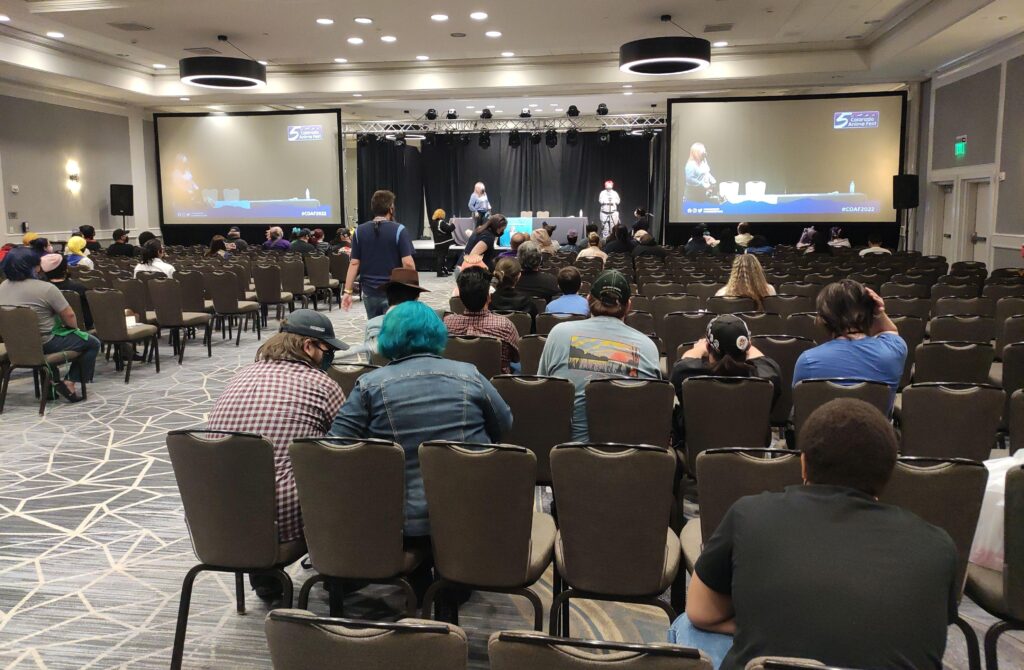
The closing ceremonies were, in my opinion, one more place where CoAF whiffed compared to NDK. For one thing, the main events room (the same one where the rave had been the previous night) was significantly smaller than NDK’s, yet it wasn’t crowded at all. Secondly, to give you an idea of the atmosphere, NDK turned the lights off and pointed spotlights at the stage, while CoAF kept the entire room’s lights on. NDK’s closing ceremonies were emotional; CoAF’s felt like they were wrapping up some business.

There was one exception to all of this: CoAF showed the AMV (anime music video) contest winners from the weekend, which NDK did not do (opting to keep the AMVs contained within their own event.) CoAF’s entries were apparently not restricted to content created during the convention, and the winners this year even included some videos created in 2020 and 2021, since CoAF hadn’t happened since 2019.

I don’t mind AMVs. They can be cool, although they can also be pretty simple, and their artistic value is limited by the fact that they just re-cut animation from anime to line up with preexisting music (there’s little opportunity for originality, in my opinion, although there can be some originality in interpretation.)
The first winner was in the Drama category, “Dopamine” by Kireblue, which was definitely an attention-grabber:
Next was the winner of the Intensity category, “Into the Madness,” also by Kireblue:
Third was the Positivity category, a welcome change of pace after the previous two. This one was taken by “Everybody Put Your Hands Up!” by Zeeruy (spot the brief Konosuba and Love Live appearances):
Fourth was the Romance category, won by “I Take This On The Weekend” by PotsAndPants. This one had some psychedelic moments:
The last two winners, I won’t embed, because they weren’t as impactful to me, personally. Second-to-last, we had the winner of the Trailers category, “Gene Lightyear” by l33tmeatwad, which wasn’t so much a music video as a parody. I hadn’t seen the anime it’s primarily featuring, so I’m not sure if I fully understood the references, but I have seen Toy Story, so I recognized the gist of the joke. Finally, we had the Wild Card category’s winner, which also won best in show for the overall contest, titled “My Next Journey” by EwiZew. This one was a crossover, a bit of a joke rotoscoping Pokémon elements into another show that I’m not familiar with.
With that, we were on to some statistics for the weekend. There were apparently 4,331 people in attendance, which was 38% higher than the last time CoAF was held (in 2019). The convention raised $6,605 for the Lending a Hand charity, which benefits people affected by the Marshall Fire in Boulder, CO at the beginning of the year.
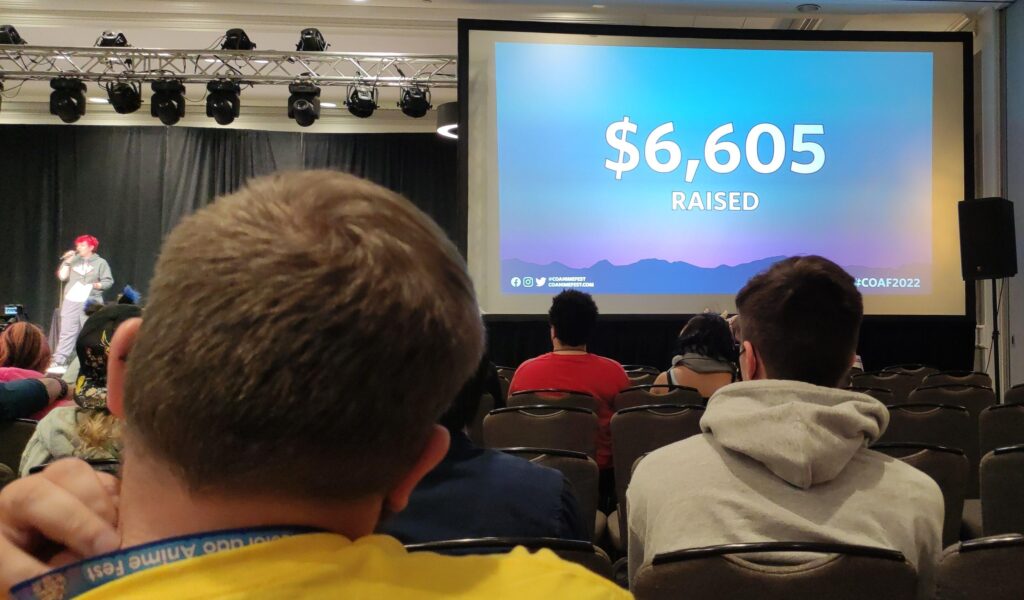
CoAF only had a few of the convention’s special guests make an appearance during the closing ceremonies; many were apparently already on their flights home at the time of the presentation. NDK, by contrast, had all of the guests lined up on stage and saying their goodbyes. It made CoAF feel like it carries less weight than NDK, and like the guests were less committed to the convention.
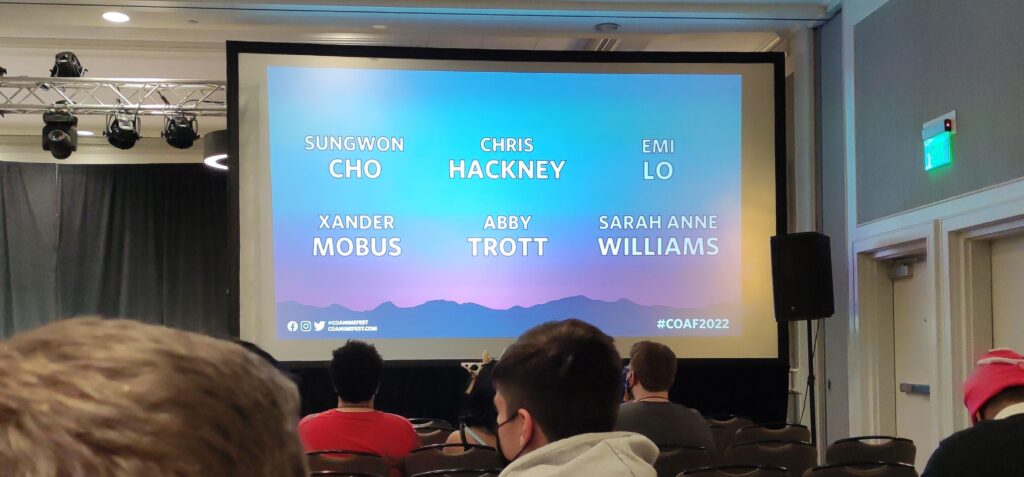
Parting Thoughts & Conclusions
I initially wasn’t going to go to CoAF this year. I’m not glad that I had to get a COVID booster to go, but I am glad that the Denver Anime meetup group talked me into going. Like with NDK, I saw some cool things at CoAF, and there were also some slow moments. It once again got me excited about Japanese culture and the things that I’m currently working towards.
In my NDK blog post, I mentioned the possibility of cosplaying in the future. After attending CoAF, I think I might need to cosplay to really feel like I fit in should I attend another anime convention by myself. The novelty of simply being there seemed to have worn off a bit this time, and I don’t necessarily see that trend improving on its own.

As for CoAF itself, I found it fairly competently run. I was very pleased with the lack of lines and easy access to most panels. I was disappointed by the small exhibitors’ hall, but while that and the smaller video game room were weak compared to NDK, I enjoyed unique CoAF offerings such as the manga library and the tabletop gaming room. I also felt that CoAF’s less restrictive after-hours programming offered some unique experiences.
I still like NDK, but I like CoAF, too. They’re two different conventions with two different atmospheres. NDK feels like a small official convention; CoAF feels like a big community gathering. While there isn’t much at all that I like about Denver, having two annual anime events can only be considered a plus.
